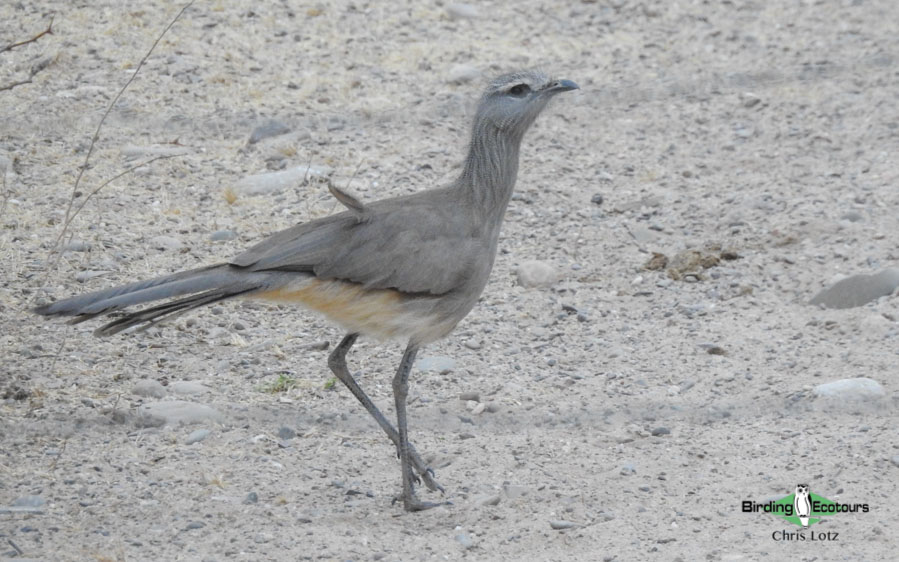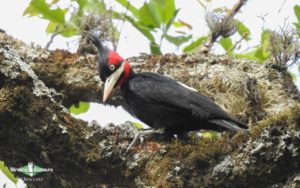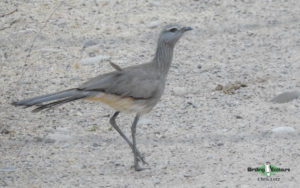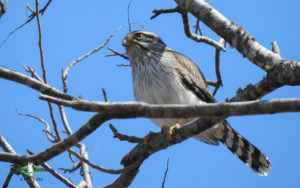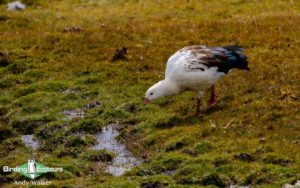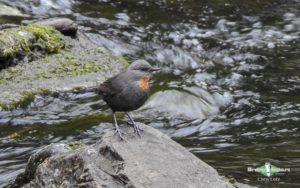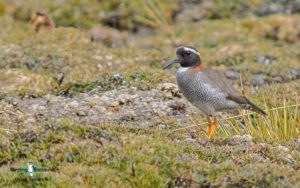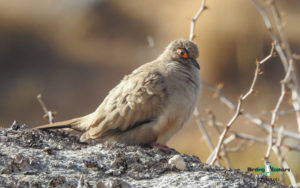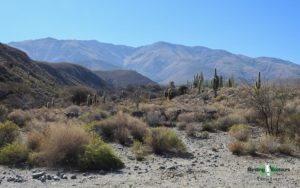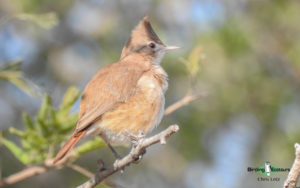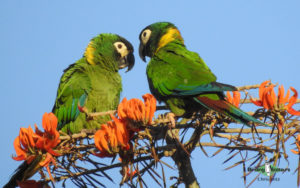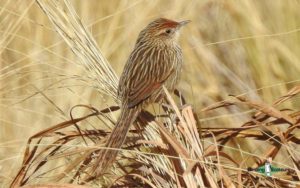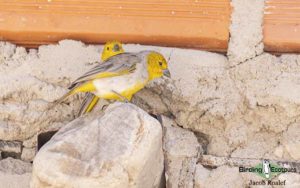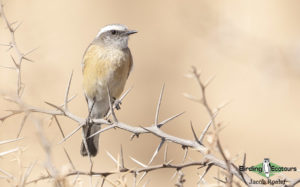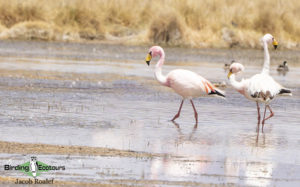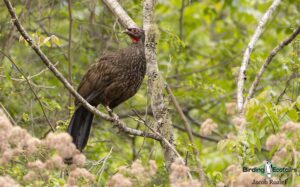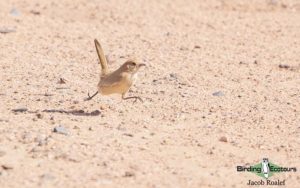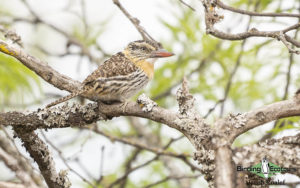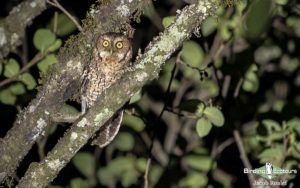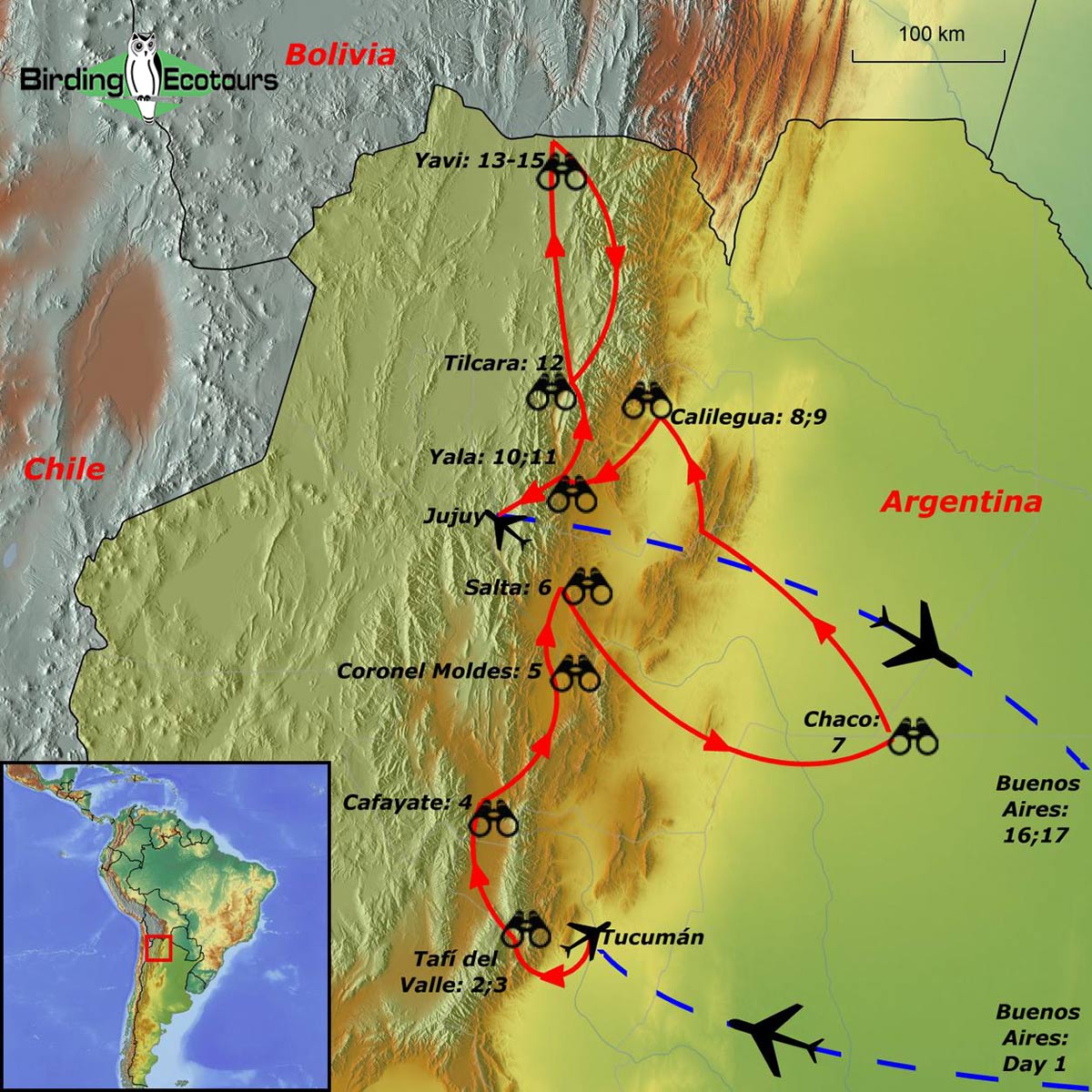Northwest Argentina: Yungas, Chaco and High Andes Birding Tour
Go to: Argentina Birding Tours | Birding Tours in the Neotropics | All our birding tours
Northwest Argentina: Yungas, Chaco and High Andes Birding Tour
October 2025/2026
Argentina is the second-largest country in South America and this birding trip offers the opportunity to travel across the northwestern section of this vast and picturesque land. We will go from lowland wetlands of Buenos Aires, through the dry Chaco shrublands and into the lush Yungas cloudforest, before we climb in elevation through the dry Andean valleys and puna mountains to the high Andes in the Altiplano where we seemingly reach the roof of Argentina at 13,000 feet (3,900 meters).
Rufous-throated Dipper is one of the most-wanted targets of the trip.
Our northwest Argentina trip can be considered one of the best birding trips in southern South America as it provides a unique set of birds found only in this part of the world which can be enjoyed by the most serious birder to those only setting foot on the continent for the first time. During this spectacular 17-day birding trip you may feast your eyes on some of the region’s most-wanted species such as Rufous-throated Dipper, Horned Coot, Diademed Sandpiper-Plover, Sandy Gallito, Red-faced Guan, Tucuman Mountain Finch, Moreno’s Ground Dove, Red-tailed Comet, Wedge-tailed Hillstar, the attractive Burrowing Parrot, White-throated Antpitta, Tucumán Amazon, Lyre-tailed Nightjar, Giant Antshrike, Black-legged Seriema and Black-bodied Woodpecker. Other more widespread yet classic neotropical species will include Andean Condor, Andean Goose, Torrent Duck and Southern Screamer, highly prized for those visiting South America for the first time.
Spectacular rock formations greet you along the way into the Andes. You will find high-altitude alkaline lakes filled with three different South American flamingo species including Chilean Flamingo, Andean Flamingo and James’s Flamingo, one of the world’s rarest members of the family. The trip will provide a unique set of waders too, such as Andean Avocet, Puna Plover, Collared Plover, Tawny-throated Dotterel, Andean Lapwing and the most-wanted Diademed Sandpiper-Plover, a highly attractive wader and considered among the 100 top birds in the world for many birdwatchers.
The great Chaco will provide you with both Black-legged and Red-legged Seriemas along with a host of other amazing Chaco birds that, with some luck, will include Lark-like Brushrunner, Black-bodied Woodpecker, Quebracho Crested Tinamou, Chaco Owl and Spot-winged Falconet.
The splendors of the Calilegua National Park include stunning birds such as Yungas Manakin, Golden-collared Macaw, Giant Antshrike, White-throated Antpitta, Tucuman Amazon and with luck Ornate Hawk-Eagle and Solitary Eagle.
Lowland marshes around Buenos Aires are full of water birds including the likes of Maguari Stork, Limpkin, Black-necked Swan, Plumbeous Rail, Whistling Heron and Southern Screamer which will all help boost our already impressive bird list and crown a fantastic trip.
All in all, this is a spectacular tour through Argentina’s famous wine-growing area taking in some of South America’s classic bird species as we traverse varied and breathtaking landscapes.
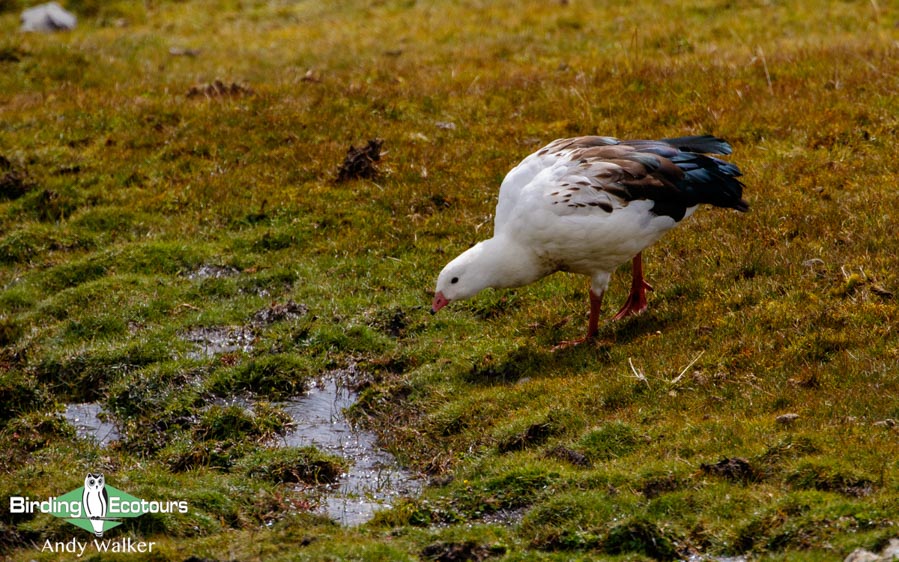
This tour can be combined with our Argentina: Northeast – Iberá Marshlands and Iguazú National Park birding tour followed by our Argentina: Southern Patagonia – Los Glaciares National Park, Austral Rail and Hooded Grebe birding tour.
Itinerary (17 days/16 nights)
Day 1. Arrival in Buenos Aires and Costanera Sur Ecological Reserve
We will meet you on arrival at the Ezeiza International airport in Buenos Aires. You will be transferred to the hotel and if time permits and the group is keen, we can spend our first afternoon birding the Costanera Sur Ecological Reserve. This is a wonderful spot located within the city where we might find Coscoroba Swan, the fabulous-looking Rosy-billed Pochard, Masked Duck, Silver Teal and many other good wildfowl species. Picazuro Pigeon, Gilded Sapphire, Checkered Woodpecker, Green-barred Woodpecker, Wren-like Rushbird, the brightly colored Red-crested Cardinal, Rufous Hornero and Guira Cuckoo are common here and are certainly full of charisma. Monk Parakeet abounds and we usually also find its stunning-looking cousin, Nanday Parakeet. Rufescent Tiger Heron, Chimango Caracara, Grey-breasted Martin, Masked Gnatcatcher and if we are lucky Long-winged Harrier.
Overnight: Hotel Pestana, Buenos Aires
Day 2. Flight to Tucumán and transfer to Tafí del Valle
We shall fly to Tucumán and drive from here to Tafí del Valle, where we spend two nights. During our drive we ascend into beautiful cloudforest (Yungas) and start looking for Rufous-throated Dipper (one of the most important birds of the trip). Other good birds to be found in the area include the spectacular Red-tailed Comet, Yellow-striped Brushfinch, Rusty-browed Warbling Finch, White-browed Tapaculo, Torrent Duck, Grey-hooded Parakeet, Aplomado Falcon, Variable Hawk, Plain-mantled Tit-Spinetail, Brown-capped Tit-Spinetail and Ornate Tinamou.
Overnight: Hostería Lunahuana, Tafí del Valle
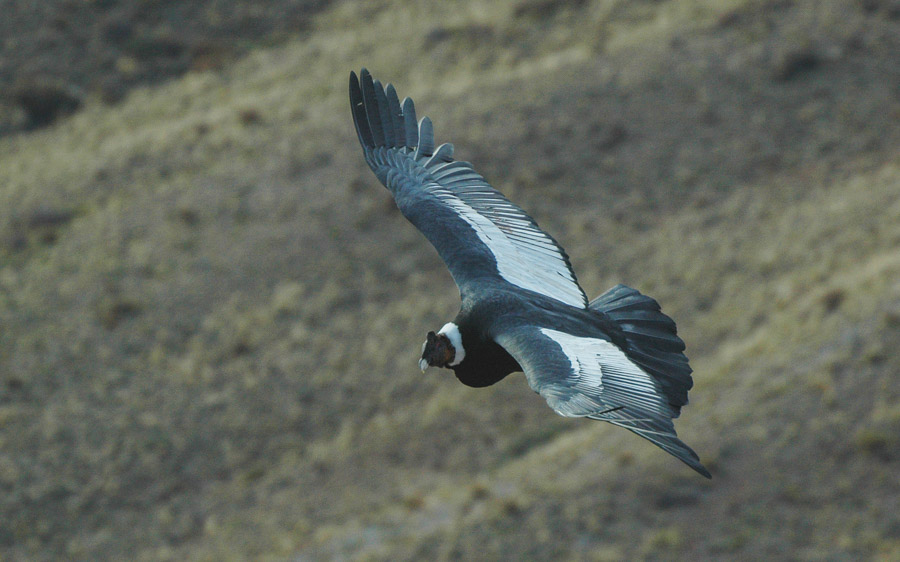
Day 3. Birding the Tafí del Valle area
This always proves to be an exciting, birding-packed day, as we bird at various altitudes. We start the day by ascending the El Infiernillo Pass until we are high above the tree line, often seeing Burrowing Owl and the good-looking Black Siskin sitting on fence posts as the van climbs. We stop and do short walks at a couple of high-altitude sites in search of a mouth-watering list of targets. These include two Argentinian endemics, Moreno’s Ground Dove and Tucuman Mountain Finch. Andean Flicker is fairly common and likes to sit atop boulders. This is also usually where we see our first Andean Condor and with luck, we might also encounter Cinereous Harrier. Various high-altitude finches abound too. We have a special site for Scribble-tailed Canastero, but this involves a steep walk, so do speak to your guide in advance in case you want to skip this. It’s worth seeing though as it’s a highly range-restricted species! While here we will also look for Rock and Buff-breasted Earthcreepers, Maquis Canastero, Monte Yellow Finch, Rufous-bellied Mountain Tanager and Brown-backed Mockingbird.
After what will hopefully have been an amazing morning, we will enjoy lunch and then head to a small lake, where we hope to see Andean Goose, Andean Coot, Andean Gull and others. Usually, we then continue back to the cloudforest to clean up on species we may have missed the previous afternoon – Rufous-throated Dipper, of course, being the main target if we haven’t seen it yet.
Overnight: Hostería Lunahuana, Tafí del Valle
Day 4. Birding the Monte Desert
We will leave Tafí del Valle and ascend the El Infiernillo Pass, continuing beyond into the dry Calchaquí Valleys and birding the majestic Monte Desert with its large cacti. The poorly-known Sandy Gallito, White-throated Cacholote (endemic) and Patagonian Mockingbird are the major targets. We will of course look for a lot of other birds, such as Greenish Yellow Finch, Rufous-sided Warbling Finch, Ringed Warbling Finch, White-browed Brushfinch, Band-tailed Sierra Finch, Black-winged and Moreno’s Ground Doves, Slender-billed and Rufous-banded Miner, Streak-fronted Thornbird, Puna Canastero, White-browed Chat-Tyrant and the noisy Greater Wagtail-Tyrant.
Overnight: Viñas de Cafayate Wine Resort
Day 5. Cafayate to Coronel Moldes
We continue our exciting journey that traverses the spectacular scenery of Argentina’s wine country looking for Long-tailed Meadowlark, Burrowing Parrot, Tufted Tit-Spinetail, Yellow-billed Tit-Tyrant, Rusty-vented Canastero, the endemic Steinbach’s Canastero, Many-colored Chaco Finch, Band-tailed Sierra Finch, Green-barred and White-fronted Woodpeckers, Golden-billed Saltator, Chaco Earthcreeper, White-tipped Plantcutter, Ultramarine Grosbeak, Pampa Finch, Stripe-crowned Spinetail, and, as always, many others.
We spend some of the morning driving through the picturesque Enchanted Valley. After lunch we spend some time birding transitional forest in the canyon formed by the Juramento River. We’ll be looking for sought-after denizens of this arid region, including Crested Gallito, Spot-winged Falconet, Red-legged Seriema, Black-chested Buzzard-Eagle and the poorly known Sandy Gallito.
Overnight: Hostería Cabra Corral, Coronel Moldes
Day 6. Bishop’s Slope via Los Cardones National Park
The scenery today arguably gets even better (if that is possible) as we drive through Los Cardones National Park and other remarkable areas. We might see our first of some unusual and spectacular hummingbirds such as Red-tailed Comet and White-sided Hillstar while Rufous-bellied Mountain Tanager is also one of our key targets. We should add further parrots to our list which might include Scaly-headed Parrot and Grey-hooded Parakeet. A high-altitude bird that we really hope will cooperate is Zimmer’s Tapaculo. Rock Earthcreeper and Rufous-banded Miner are usually easy enough to find.
Then we will head to Salta looking for Cream-backed Woodpecker, Smoke-colored Pewee, Rough-legged Tyrannulet, White-bellied Hummingbird, the beautiful Plush-crested Jay, Golden-winged Cacique and Grey-cowled Wood Rail.
Overnight: Hotel Boutique Villa Vicuña, Salta
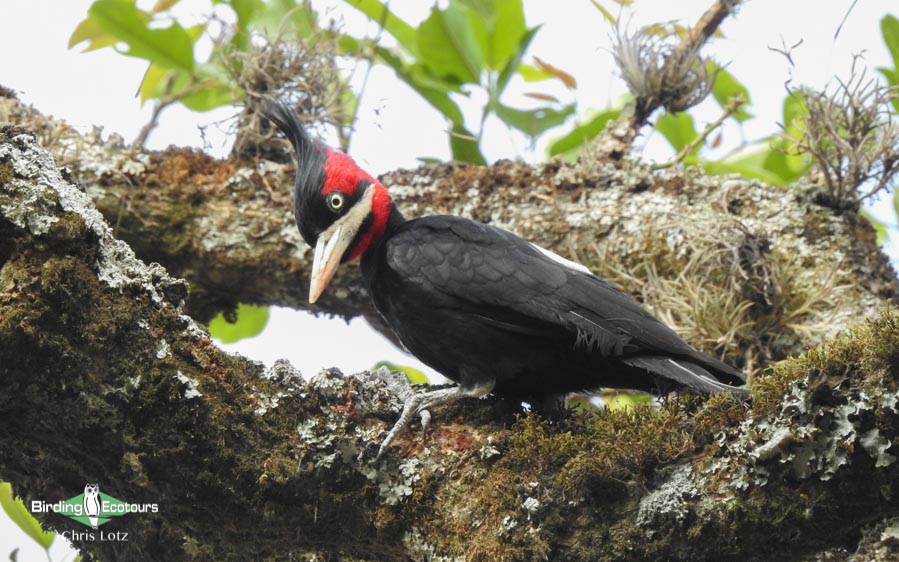
Day 7. Salta to the Chaco habitats of Joaquín V. González
Today we shall explore El Chaco where a diverse array of new birds awaits us. This dry desert, dominated by scrub and large cacti, is found only in northern Argentina, Paraguay and southern Bolivia. There is a long list of immensely-wanted species, such as Black-legged Seriema, Tataupa Tinamou, Brushland Tinamou and the spectacular-looking Quebracho Crested Tinamou, Chaco Chachalaca, Many-colored Chaco Finch, the sought-after Black-bodied Woodpecker, spectacular woodcreepers such as Red-billed Scythebill, Scimitar-billed Woodcreeper, Great Rufous Woodcreeper and their smaller relative, Narrow-billed Woodcreeper. Chaco Puffbird will hopefully be added to our list at some point. Spot-winged Falconet is never easy and it usually needs quite a bit of work. Much easier are Lark-like Brushrunner, Crested Hornero, the sometimes-skulking Crested Gallito, Chaco Earthcreeper should hopefully be found too while new parrot species add splashes of color. As always, there are far more birds than we can mention here and these two days represent the most productive days of the trip in terms of adding many high-quality species to our growing bird list. We should mention that we’ll be sure to try for Chaco Owl at night.
Overnight: Las Lajitas, Chaco
The most-wanted Black-legged Seriema is one of the main targets in the Chaco.
Day 8. Chaco habitats at Joaquin V. González to Calilegua National Park
This is another day looking for specials of the thorny habitats of the Chaco woodlands. Among the many species we might encounter are Greater Rhea, Tataupa Tinamou, Bicolored Hawk, Blue-crowned Parakeet, Striped Cuckoo, Ferruginous Pygmy Owl, Blue-tufted Starthroat, Chaco Puffbird, Chaco Earthcreeper, White-barred Piculet, White Woodpecker, Campo Flicker, Turquoise-fronted Amazon, Great Antshrike, Variable Antshrike and Stripe-backed Antbird. From here, we drive to Calilegua National Park, looking for birds we may have previously missed.
Calilegua National Park is a stunning destination for birding. It protects important Yungas cloudforest habitat and we will get to explore this impressive park and its avifauna over the next couple of days.
Overnight: Posada del Sol, Calilegua
Day 9. Birding Calilegua National Park
We spend an entire day in Calilegua National Park itself and on the second day we bird beyond the park as far as the small town of San Francisco. We have a long list of tantalizing birds to find. The steep, forested slopes are home to birds like Black-and-white Hawk-Eagle, Black-and-chestnut Eagle, Solitary Eagle, Bat Falcon, Dusky-legged Guan, Golden-collared Macaw, Speckled Hummingbird, Blue-capped Puffleg, Slender-tailed Woodstar, Blue-crowned Trogon, Yungas Manakin, Golden-olive Woodpecker, Great Rufous Woodcreeper, Black-banded Woodcreeper, Giant Antshrike, Sclater’s Tyrannulet, White-throated Antpitta, Mountain Wren, Sclater’s Nightingale-Thrush, Glossy-black Thrush, Rusty-browed Warbling Finch, Grey-browed Brushfinch, Crested Oropendola and Yungas Pygmy Owl.
Overnight: Posada del Sol, Calilegua
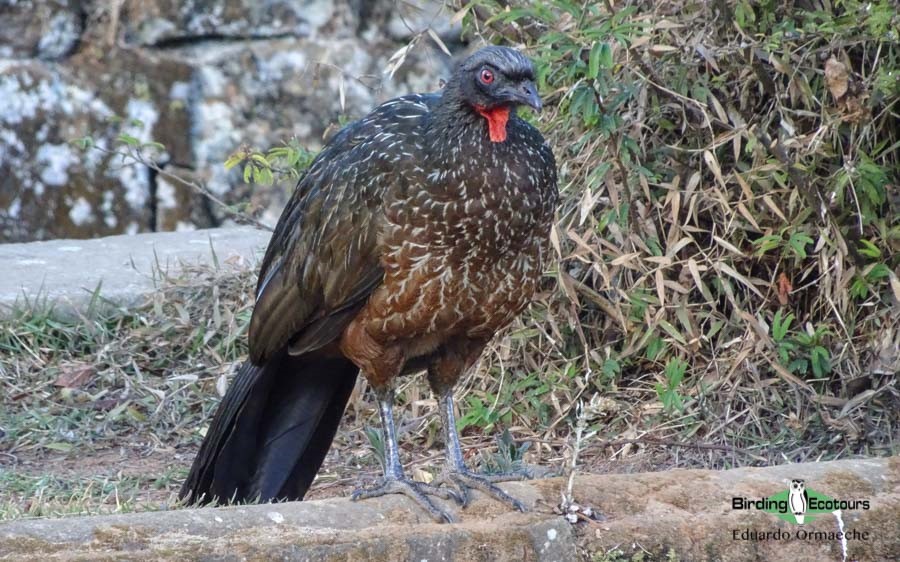
Day 10. Calilegua to Potrero de Yala Provincial Park
Today will be our second day birding in this lush region of Calilegua National Park. We shall look for species such as Blue-crowned Trogon, Toco Toucan, Dot-fronted Woodpecker, Streaked Xenops, Ochre-faced Tody-Flycatcher, Mottle-cheeked Tyrannulet, Saffron-billed Sparrow, Two-banded Warbler, Orange-headed Tanager, Ochre-cheeked Spinetail, Brown-capped Whitestart, Andean Slaty Thrush, White-tailed Kite, Swallow-tailed Kite and the shy White-browed Tapaculo.
Over the last few years, a pair of Harpy Eagles has sometimes been seen from the upper roads of the park, although we would consider ourselves most fortunate with a sighting of this massive eagle! In the afternoon we will drive from Calilegua to Potrero de Yala Provincial Park, another wonderful transitional Yungas habitat.
Overnight: La Posta del Lozano, Yala
Day 11. Potrero de Yala Provincial Park
Today we will have a predawn start to look for some night birds including the spectacular male Lyre-tailed Nightjar and Yungas Screech Owl which are usually not too difficult to find on the outskirts of town. Red-faced Guan is one of our major targets and can be tricky, but of course we usually find it with persistence. The localized Tucuman Amazon is another target of this trip. We shall look for the Streak-throated Bush Tyrant, Chilean Elaenia, Rufous-capped Antshrike, Spot-breasted Thornbird, Buff-browed Foliage-gleaner, Mountain Wren, Sooty-fronted Spinetail, Blue-and-yellow Tanager, Glittering-bellied Emerald, Yellow-browed Tyrant, Crested Becard and Golden-rumped Euphonia.
Overnight: La Posta del Lozano, Yala
Day 12. Birding the Humahuaca Ravine
Today we drive higher along the Humahuaca Valley, birding the puna salt lakes and highland-lake habitats as we approach the town of La Quiaca on the Bolivian border at 12,000 feet (3,650 meters). We’ll bird the dry valley along the way, looking for Lesser Rhea, Andean Condor, Mountain Caracara, Mountain Parakeet, Andean Swallow, Rufous-banded and Puna Miners, Puna Yellow Finch, Andean Negrito, Brown-backed Mockingbird, Black-hooded Sierra Finch and Black Siskin.
From La Quiaca we drive south, passing the Laguna de los Pozuelos National Park, a huge Altiplano lake, where we have a chance to see the most-wanted Horned Coot. From here we will continue our drive towards Tilcara.
Overnight: Hotel Las Marias, Tilcara
Day 13. Puna Lakes and transfer to Yavi
From Tilcara we continue driving northward (and higher), passing a number of lakes, where we have the chance to admire the stunning Argentinean Altiplano, while hopefully finding Andean Gull, Andean Coot, Giant Coot, Andean Goose, Puna Teal, Crested Duck, Puna Ibis, Andean Avocet, Puna Plover, Chilean, Andean and James’s Flamingos, Cordilleran Canastero and Grey-breasted Seedsnipe.
Overnight: Posada Tika, Yavi
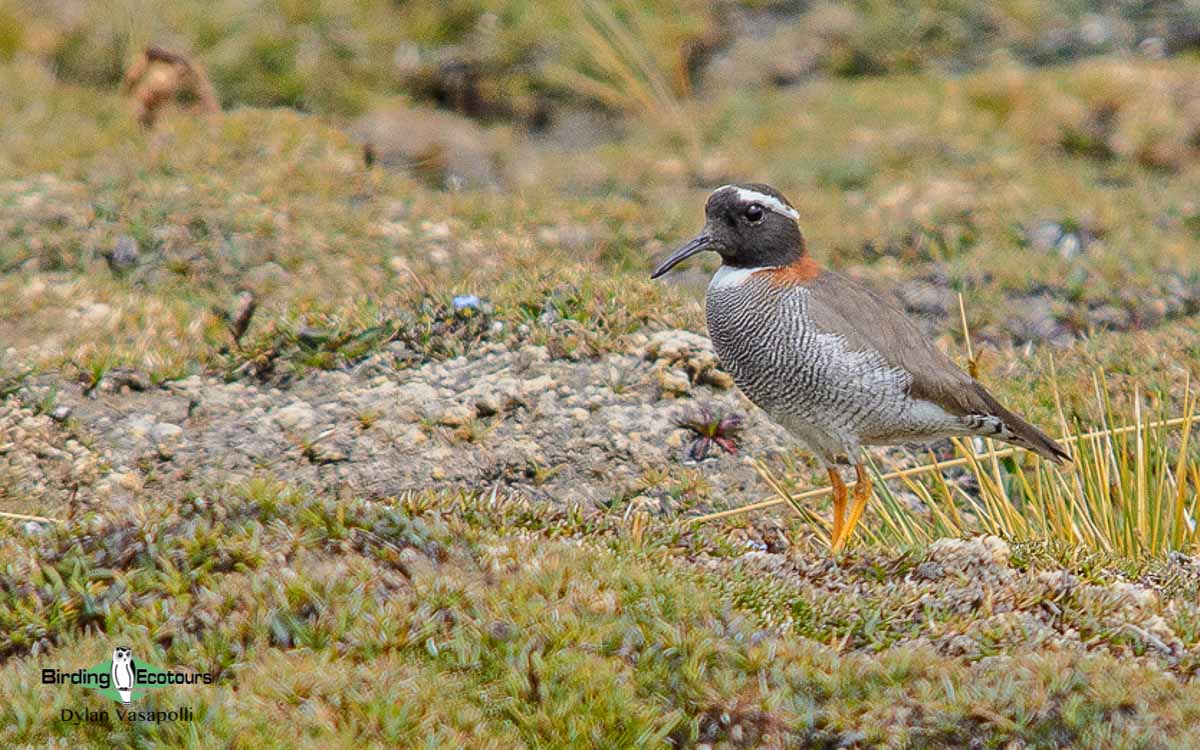
Day 14. Yavi
Yavi is a small hamlet that is home to the range-restricted Citron-headed Yellow Finch. We will also bird the highland valleys above, looking for Rufous-backed Inca Finch. Here we will also have a chance for Mourning Sierra Finch, Puna and Bright-rumped Yellow Finches, Black-billed Shrike-Tyrant, Cream-winged Cinclodes and Spot-winged Pigeon. The star bird we’ll be looking for, however, is Diademed Sandpiper-Plover, a rare high-elevation wader restricted to mossy tundra, grasslands and bogs in northern Argentina, Chile, Bolivia and Peru.
Overnight: Posada Tika, Yavi
Day 15. Birding the high Puna
From Yavi we ascend to over 12,000 feet (3,650 meters) above sea level, searching for further specials such as Lesser Rhea, Ornate Tinamou, Puna Tinamou, Puna Yellow Finch, Puna, Spot-billed and Rufous-naped Ground Tyrants, Grey-bellied Shrike-Tyrant, Straight-billed Earthcreeper, Golden-spotted Ground Dove, Common Miner, Puna Miner and Andean Swallow. The high Andes of this section of Argentina are good to see other wildlife like wild Guanaco, Vicuna, Montane Vizcacha and with luck the distinctive Highland Tuco-Tuco, an endemic burrowing rodent of this part of the continent that resembles North American Prairie Dogs.
Overnight: Posada Tika, Yavi
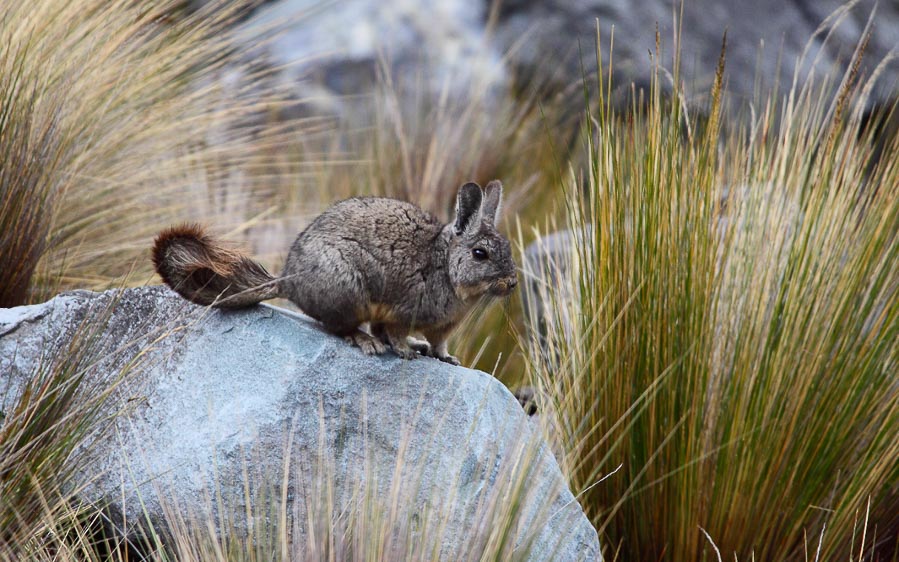
Day 16. Flight from Jujuy to Buenos Aires
We bird the area further, then eventually drive to Jujuy (about 1.5 hours away) for our afternoon flight back to Buenos Aires. Here, back in the big city, we hope to have some time to clean up on birds we may have previously missed.
Overnight: Hotel Pestana, Buenos Aires
Day 17. Otamendi Reserve and transfer to Ezeiza International airport
On our last day, we will invest some time in the morning to visit the Otamendi Reserve near Buenos Aires. The wetlands here hold a large amount of water species including Southern Screamer, Brazilian Teal, Limpkin, Snowy and Great Egrets, Whistling Heron, Giant Wood Rail, Plumbeous Rail, Black-necked Swan, Anhinga, Wood Stork, Maguari Stork, Cocoi Heron, Rufescent Tiger Heron, White-winged Coot, White-faced Ibis, Cinnamon Teal, Wattled Jacana and Fulvous Whistling Duck. Other species include Snail Kite, Grassland Yellow Finch, Many-colored Rush-Tyrant, Yellow-chinned Spinetail and the most wanted Curve-billed and Straight-billed Reedhaunters, both secretive reed dwellers and among the most-prized furnarids for birders.
After a busy morning at Otamendi we shall return to the hotel and be transferred to the Ezeiza International airport to connect our international flights.
Please note that the itinerary cannot be guaranteed as it is only a rough guide and can be changed (usually slightly) due to factors such as availability of accommodation, updated information on the state of accommodation, roads, or birding sites, the discretion of the guides and other factors. In addition, we sometimes have to use a different international guide from the one advertised due to tour scheduling.
Download ItineraryNorthwest Argentina: Yungas, Chaco, and High Andes Trip Report
10 – 27 OCTOBER 2022
By Jacob Roalef
DOWNLOAD TRIP REPORT
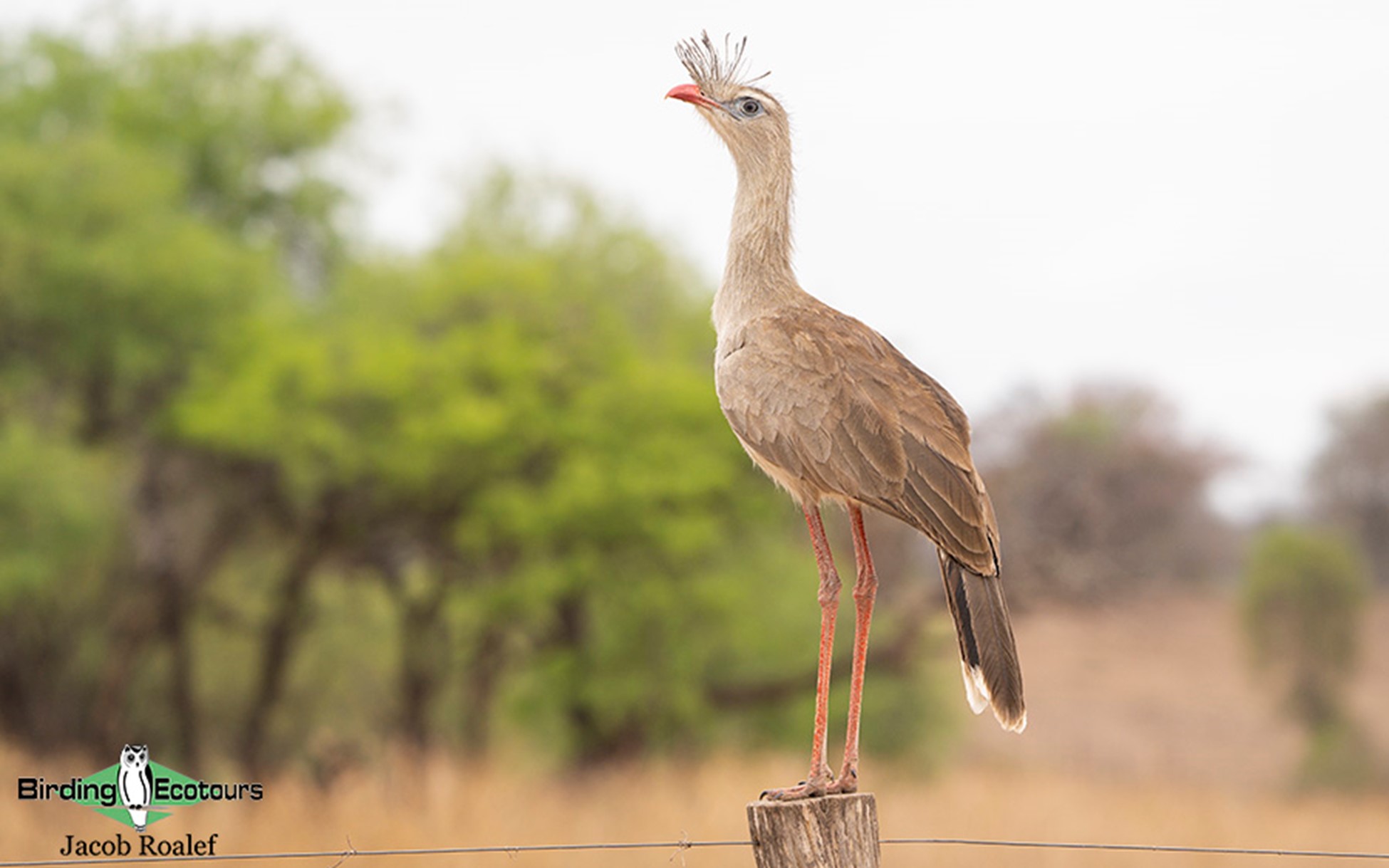
Overview
This incredible set departure tour of Argentina began in Buenos Aires with one day of birding before taking a domestic flight to Tucuman and exploring the northwest provinces of Tucuman, Salta, and Jujuy before eventually flying back to Buenos Aires for more birding and the tour’s conclusion. Some incredible birding locations were visited including Ceibas Road, Calilegua National Park, the Monte Desert, Potrero de Yala Provincial Park, Cardones National Park, dry Chaco, Lizoite Vega, Laguna Runtuyoc and Costanera Sur Ecological Reserve.
The tour was very successful as it connected with many endemic and near-endemic species along with regional specials and migrants, summing up to a great trip list. Avian highlights included Red-legged Seriema, Red-faced Guan, Diademed Sandpiper-Plover, Sandy Gallito, Moreno’s Ground-Dove, Spot-backed Puffbird, Black-crowned Monjita, White-browed Tapaculo, Steinbach’s Canastero, White-throated Cacholote, Rufous-capped Antshrike, Montane Forest Screech-Owl, James’s, Chilean and Andean Flamingos, Tucuman Mountain Finch, Cream-backed Woodpecker, Giant Coot, Red-tailed Comet, Rufous-throated Dipper and Andean Tinamou.
A total of 345 bird species were seen with one additional heard only species bringing the total recorded to 346. In addition to the birds, some nice mammals were spotted including Vicuna, Guanaco, Southern Mountain Viscacha, Azaras’s Capuchin, and Gray Brocket. Full bird and mammal checklists can be found at the end of the report.
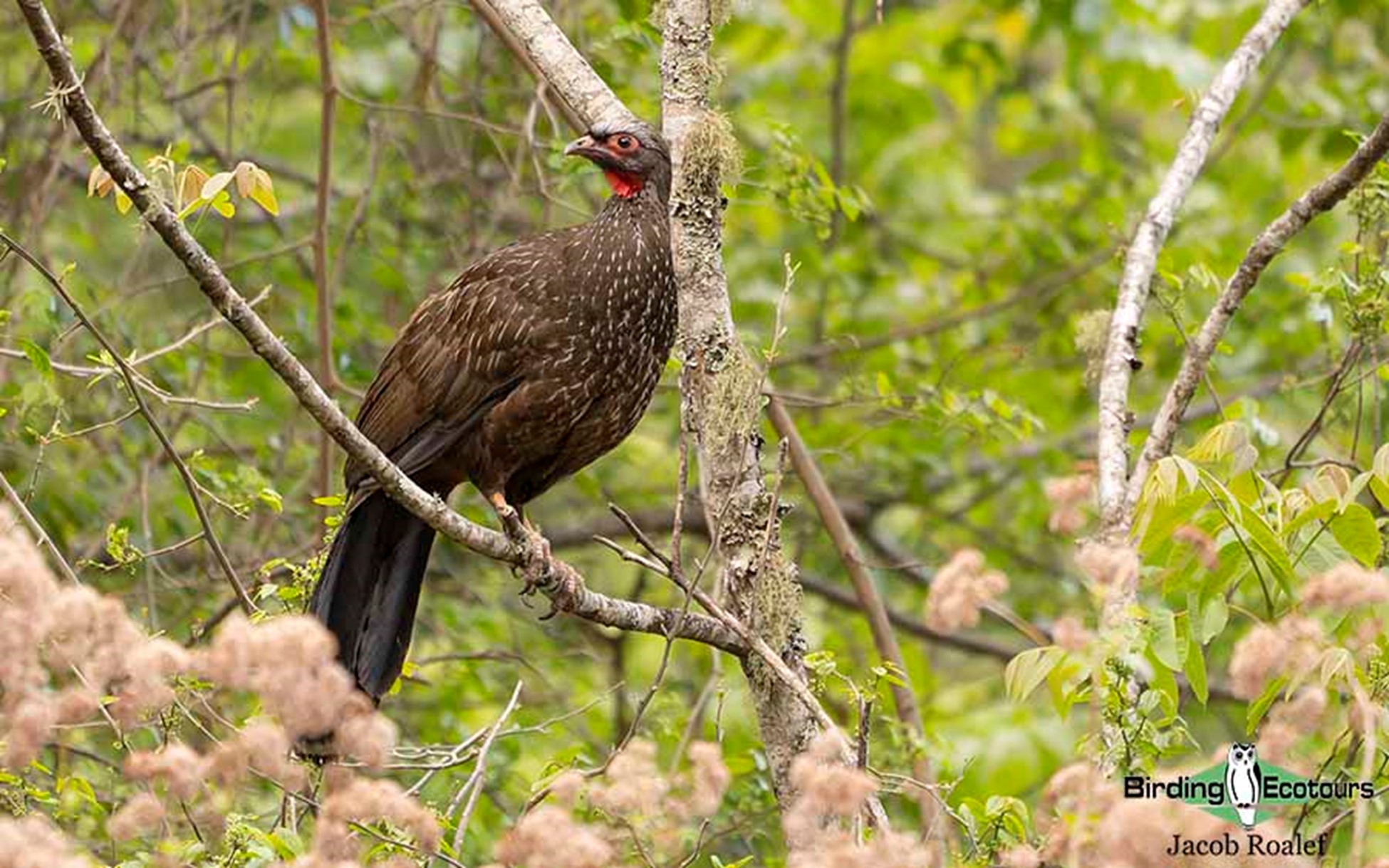
Detailed Report
Day 1, 10th October 2022. Birding along Ceibas Road
All participants of the tour arrived the previous day and after a bit of birding in Buenos Aires parks were ready to get the tour started! Due to the holiday weekend in Argentina, we decided it was best to head outside the city, so we headed off to the fabulous birding area of Ceibas Road. This massive delta area mixed with open cattle grazing and savannah habitats is amazingly bird-rich and provided opportunity to see some species that are not present in the northwest. We started off the morning getting familiar with a few of the more common species such as Rufous Hornero, Blue-and-white Swallow, Crested Caracara, Saffron Finch, Picui Ground Dove, and of course the ubiquitous Rufous-collared Sparrow. We spent most of the morning walking slowly up the roadside as there were birds everywhere we turned. It was an excellent first morning ticking off more than 60 species including Whistling Heron, White-fronted Woodpecker, Savannah Hawk, Brown Cacholote, Chotoy Spinetail, White-naped Xenopsaris and Blue-grey Saltator. We then headed off for lunch together and our first of many delicious empanadas!
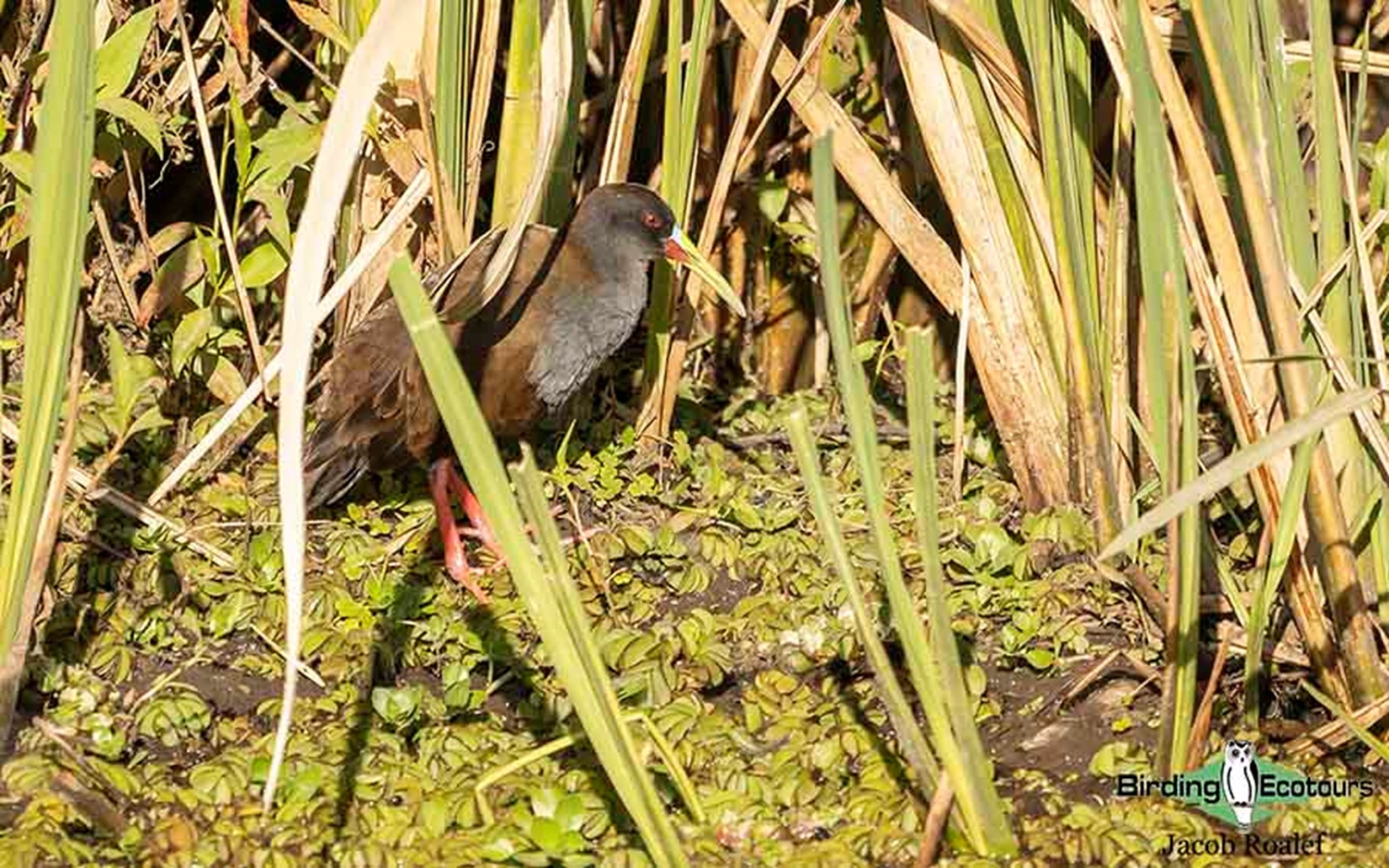
After filling up our bellies, we headed back out to Ceibas Road and picked up where we had left off. We stopped at a small puddle, again noting the gorgeous Whistling Heron, along with Silver, Brazilian, and Ringed Teals and Southern Screamer. A bit further along the road we were enamored with a family of stunning White Woodpeckers on a telephone pole and the amazing nest-building skills of the Firewood-gatherer. From here, we continued up the long road and got into more wetland habitat which provided even more species diversity. A few of the highlights included Plumbeous Rail, Warbling Doradito, White Monjita, Brown-and-yellow Marshbird, Long-winged Harrier, Sulphur-bearded Reedhaunter and Yellow-browed Tyrant. On our journey back to Buenos Aires our driver spotted a gorgeous Scarlet-headed Blackbird just before leaving Ceibas! This was a fantastic bird to cap off a fantastic first day.
Day 2, 11th October 2022. Flight to Tucuman and Birding Sosa River and Dique la Angostura
Very early we went to the airport to catch our domestic flight to Tucuman, for our first taste of northwest Argentina. After a smooth flight, we gathered our luggage and headed towards Tafi del Valle. A brief rest stop along the way yielded Roadside Hawk and Sayaca Tanager. After arriving in Tafi, we enjoyed a nice lunch and checked into the hotel before an afternoon session of birding. First up was Dique la Angostura, a sizable body of water hosting some nice water species including Andean Goose, Red Shoveler, Andean Coot, Grey-hooded Gull and Yellow-billed Pintail. Then we explored a few stops along the gorgeous Sosa River. Highlights from here included two endemics, White-browed Tapaculo and Yellow-striped Brushfinch! Just before heading back, we made another stop on the bridge overlooking the river and enjoyed views of the always brilliant Torrent Duck as it worked its way upriver. It was then time for dinner and some needed rest after a long day of travel and birding.
Day 3, 12th October 2022. Infiernillo Pass and more Sosa River
We enjoyed some coffee and breakfast before driving to Infiernillo Pass and some higher altitude birding. It was a beautiful morning, with perfect weather for exploring the grasslands here. Right away we were treated to excellent views of Variable Hawk, White-browed Chat-Tyrant, Grey-hooded Parakeet, and Red-tailed Comet. As we wondered further into the grasses, we picked up more and more birds including Hellmayr’s Pipit, Andean Flicker, Black-winged Ground Dove, and Streak-fronted Thronbird. We also had a gorgeous Black-chested Buzzard Eagle and got onto the endemic Tucuman Mountain Finch. Our next stop involved hiking along a small stream bed, where we saw a small group of the endemic Moreno’s Ground Dove. Other highlights included Buff-breasted Earthcreeper, Puna and Cordilleran Canasteros, Black Siskin and Plumbeous Sierra Finch. At the top of the pass, we enjoyed the breathtaking views and picked up a Black-billed Shrike-Tyrant, before heading back to Tafi for lunch.
We headed back to the Sosa River for the afternoon. We saw some of the same species from the previous day, like Yellow-striped Brushfinch, Brown-capped Whitestart and Mountain Wren, as we continued to scour up and down the fast-moving river for our main target. At our final location we were successful! A pair of Rufous-throated Dippers were working up and down the stream, and after hiking down closer to the edge we all had amazing views of this top target species. On our way back to dinner, we made one final brief stop at Dique la Angostura, which produced a few more new species like Coscoroba Swan and Cinnamon Teal. Then it was back to Tafi del Valle for another lovely dinner.
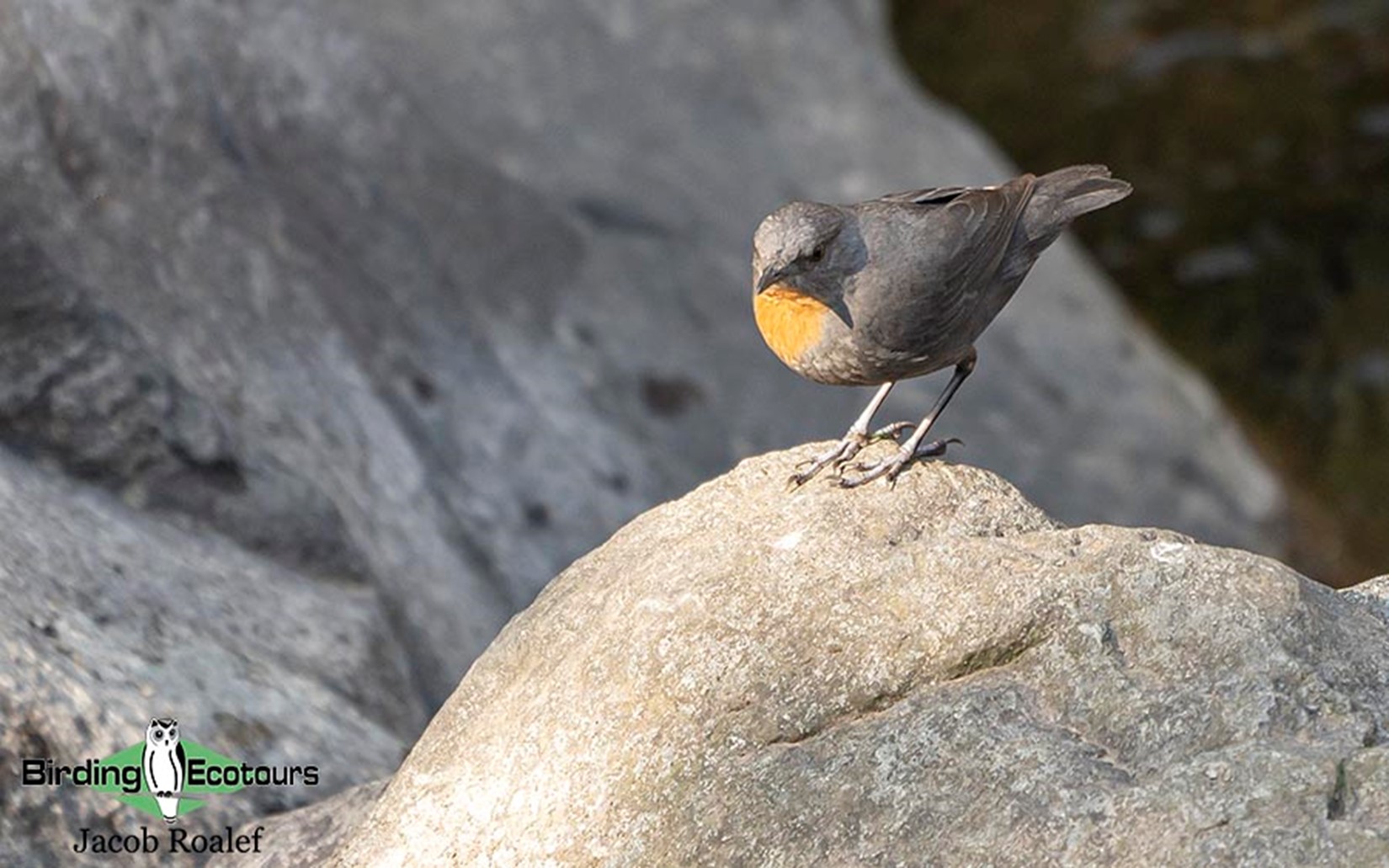
Day 4, 13th October 2022. Monte Desert birding
We packed up our things and headed up and through the Infiernillo Pass to begin the day. Along our early morning drive, we spotted an Andean Tinamou along the side of the road. Surprisingly, it allowed us to stop and get a view before flushing off into the grass. Not much further up the road, an Ornate Tinamou scurried across, and we all managed a view of it as well. Two tinamou species in about 20 min! After cresting the pass, we began our descent and journey towards Cafayate, with multiple stops and targets planned along the way in the Calchaqui Valley. At our first quick stop we scored many firsts for the trip, including Greenish Yellow Finch, Rufous-banded Miner, Burrowing Parrot, Creamy-breasted Canastero and Giant Hummingbird. At our next stop we had great success with the top target, Steinbach’s Canastero, plus we ticked Rufous-sided Warbling Finch and Yellow-billed Tit-Tyrant. We made such great time with the targets in the valley that we decided to bird a little in the Monte Desert. While it is never easy birding desert habitats, we persevered and scored the endemic White-throated Cacholote, along with the endemic breeder Black-crowned Monjita.
We headed back to the town of Amaicha for lunch and managed to pick up new birds for the trip. We shared our lunch with Ringed Warbling Finch, Greyish Baywing, Patagonian and White-banded Mockingbirds and Blue-and-yellow Tanager. After some very welcome ice cream, we continued through the desert and made a quick stop along the Santa Maria River, picking up several new species such as Baird’s Sandpiper, Cliff Flycatcher and Andean Swift. For our final activity of the day, we visited the fascinating Quilmes Ruins and soaked in their history. At Cafayate we enjoyed an incredible dinner, many laughs, and lots of fun!
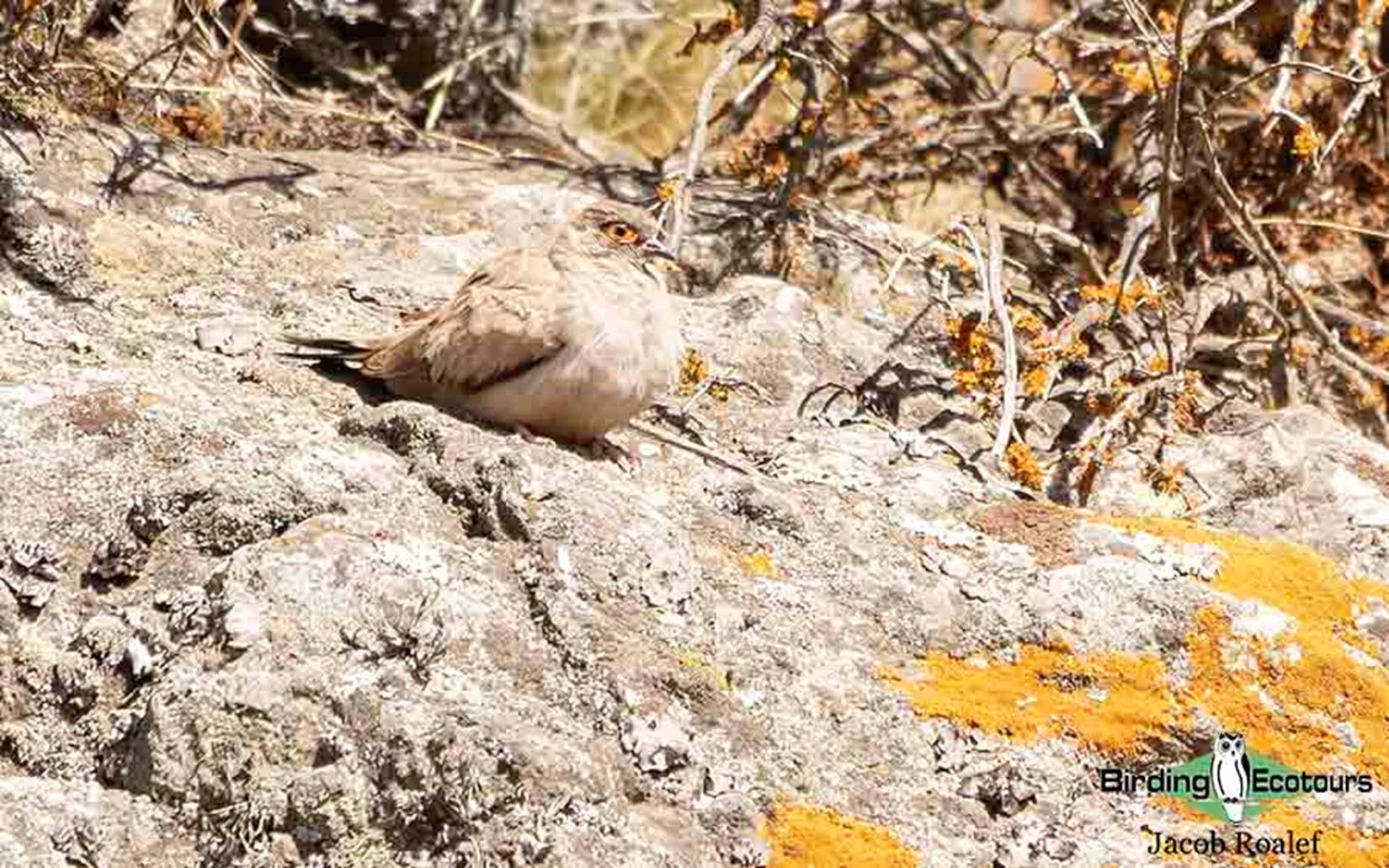
Day 5, 14th October 2022. Valley of Cafayate and more Monte Desert
The morning was spent exploring the valley of Cafayate with one major target in mind. Our first few stops, and searches proved unsuccessful, however, we did enjoy other species like Glittering-bellied Emerald, Chaco Earthcreeper, Greater Wagtail-Tyrant, Great Pampa Finch and Grey-hooded Sierra Finch. At our third or maybe fourth location, we spread out, searching the sandy and rocky soil until finally we heard what we were after, Sandy Gallito! This little roadrunner-like bird was amazing to watch as it sprinted from bush to bush, making its loud calls. This was a fantastic success after so much effort and searching.
We went for lunch, where we were greeted by a Variable Oriole attempting to nest in a structure attached to the building. After our tasty empanada lunch, followed by something sweet from the store, we looked around the grounds and were surprised by just how birdy the yard and surrounding woods were. We spent the next hour and a half exploring the area and tallying an impressive list of 35 species from just this lunch stop! Many new species were added to our trip list like Chaco Chachalaca, Pearly-vented Tody-Tyrant, Tropical Parula, White-bellied Tyrannulet, Red Pileated Finch, Ultramarine Grosbeak and Black-capped Warbling Finch. After this we continued our drive towards the hotel in Coronel Moldes, making one last stop at a nice body of water along the road. Species included Blue-crowned Parakeet, Tawny-headed Swallow, Red-fronted Coot, Coscoroba Swan and White-tipped Plantcutter. Before dinner at the lodge, we sat next to the pool and enjoyed the view of the impressive lake below, while picking up Cocoi Heron, Great Grebe and Golden-billed Saltator. This was a lovely end to a very successful day.
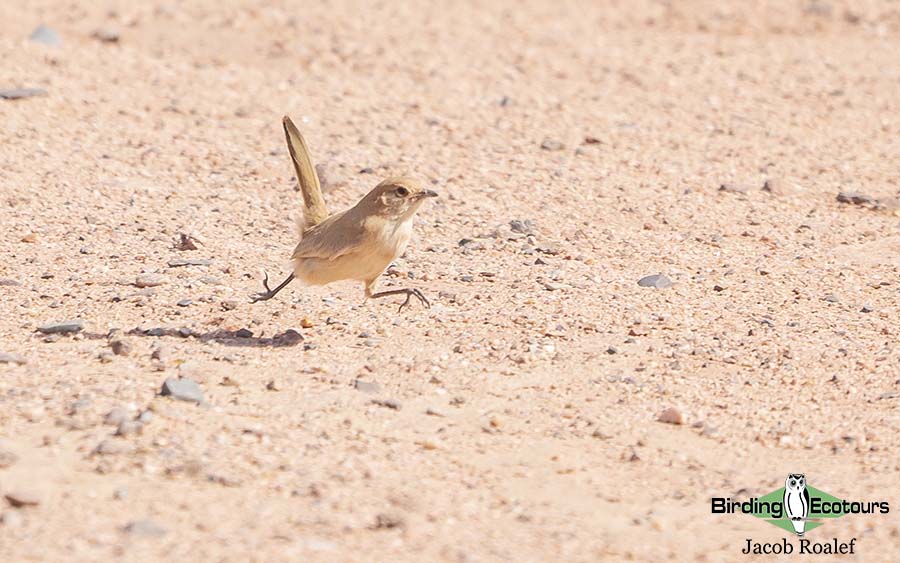
Day 6, 15th October 2022. Cardones National Park and the Lowlands of North Moldes
We began our day with breakfast outside on the patio, while enjoying the spectacular view. Of course, we had a few avian guests wanting to share our breakfast, including Saffron and Red Pileated Finches, Golden-billed Saltator, Shiny Cowbird, Chiguanco Thrush and Black-capped Warbling Finch. As we were loading up the van, a small group of Cliff Flycatchers put on a nice display for us. While driving, we spotted a pair of Black-legged Seriema out in a distant field! We all shuffled out and enjoyed some nice scope views of these strange birds. During our observation, a White-barred Piculet dropped in nearby and a pair of Muscovy Ducks flew by. We were happy to get a few more good birds to add to our trip list! The remainder of the afternoon was spent enjoying the beauty of Cardones National Park and surrounds.
Upon entering the lowlands, we noted several new species for the trip, like Buff-necked Ibis and Yungas Guan. We continued to the mid and upper elevations and walked slowly along the side of the road, looking for our top targets of the day. Although, things were slow in terms of numbers, we managed to find our first target relatively quickly. A pair of the very localized Rufous-bellied Mountain Tanagers perched up nicely for all of us to get good views, before disappearing. Along this stretch we also noted Tufted Tit-Tyrant, White-browed Ground-Tyrant and the endemic Tucuman Mountain Finch. Further up the road we picked up our next big target, Maquis Canastero, along with Rock Earthcreeper and Cream-winged Cinclodes. We continued to climb in altitude and spotted our first iconic mammal of the trip, the Guanaco. The wind was picking up and so birding was slow, but we enjoyed the stellar views. We made it through to the Tin-Tin Straight, where we enjoyed lunch before heading back down and out of the park. On our way out, we stopped for coffee and found a White-winged Black-Tyrant displaying nearby. It was hilarious watching this funny bird jump up and down on top of a very tall cactus. We continued our journey to Salta and enjoyed a lovely evening exploring the culture and food of this fantastic city.
Day 7, 16th October 2022. Palomitas and intro to Calilegua National Park
After breakfast, we headed out to do some birding near the tiny town of Palomitas. A gravel road held many great species for us to discover. Our morning walk began with numerous highlights, including Spot-backed Puffbird, Many-colored Chaco Finch, Checkered Woodpecker and Stripe-crowned Spinetail. As we continued along, a gorgeous adult Crane Hawk was perched in the distance and gave us some lovely views before flying off. A nice open area looked great for one of our targets. We played some calls and three Red-legged Seriemas sprinted towards the van from out of the tall grasses! They looked just like velociraptors from a Jurassic Park film! They called back and circled the van as if they were closing in on their prey! It was an amazing and unforgettable experience. On our way back, we spotted a family group of about a dozen Guira Cuckoos flying about from tree to tree. Another spectacular showing!
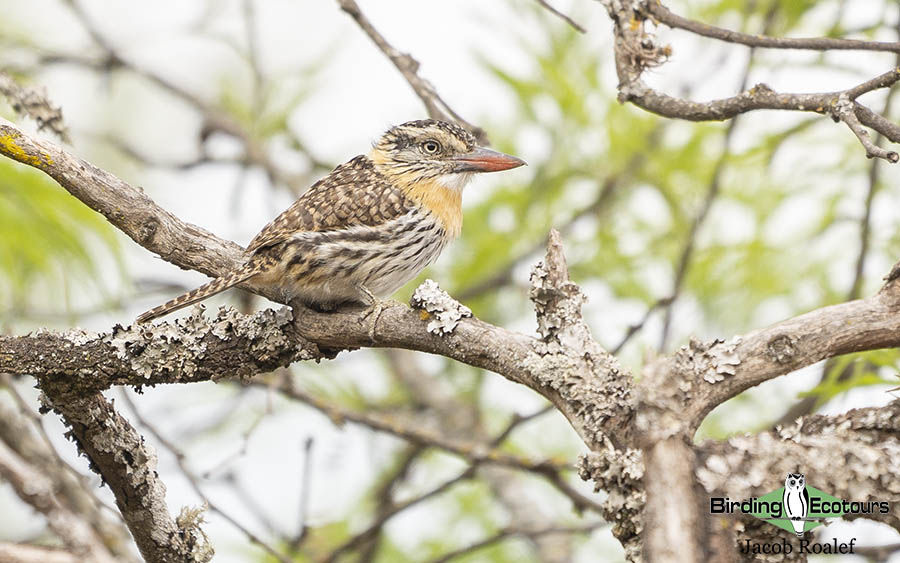
A two-hour drive to San Martin for lunch and a little rest was followed by some afternoon birding. We met up with our local guide for the area and headed into Calilegua National Park for our first taste of birding the amazing forests. We started in the lowlands and right away were onto some Scaly-headed Parrots and Green-cheeked Parakeets. A few of the bizarre looking Plush-crested Jays were interested in us and came down for a closer look. We started onto the trail where things were a bit slow, but the quality of species were high. We noted many firsts for the trip, like the impressive Cream-backed Woodpecker and the brilliant Blue-crowned Trogon. Further along the trail were more new species, including Streaked Xenops, Buff-browed Foliage-gleaner Golden-olive Woodpecker, Southern Beardless-Tyrannulet and Yellow-olive Flatbill. On our final stretch, just before getting back to the van, we spotted two more fantastic targets, the huge Toco Toucan, and a pair of amazing Golden-collared Macaws! This was certainly a fine introduction to the wonders of this national park.
Day 8, 17th October 2022. Mid-Lowland Forests of Calilegua National Park
We had the full day to explore and bird Calilegua National Park. We started off in the mid-elevations of the parks and worked our way down from there. Things started off strong with many fantastic species like Crested Oropendola, Two-banded Warbler, Piratic Flycatcher, Rusty Flowerpiercer, Ochre-faced Tody-Flycatcher, Yungas Manakin, Azara’s Spinetail and Sparkling Violetear. As we moved down along the road, we slowly picked up more and more species in the dense brush and growth. Highlights included Orange-headed Tanager, White-bellied and Speckled Hummingbirds, Dot-fronted Woodpecker, Slaty and Highland Elaenias, Andean Slaty Thrush and White-browed Brushfinch. After this four-hour birding session of the mid-elevations, we loaded back into the van and headed towards lunch. Along the way we picked up the always beautiful Roseate Spoonbill, as well as Guira Cuckoo and Southern Rough-winged Swallow. After lunch we hit the low-elevations again, picking up serval nice species including Olivaceous Woodcreeper, Smoke-colored Pewee, Black-capped Antwren and Variable Antshrike. We headed to dinner and the hotel for the night to get some well-deserved rest.

Day 9, 18th October 2022. Upper Mountain Forests of Calilegua National Park
The forecast was grim for today’s adventure as we dealt with rain and heavy fog for most of the day. Despite the weather, we were determined to make the most of the day as we headed to the upper mountain forest sections of Calilegua. Right away we were treated to great looks at Fulvous-headed Brushfinch and Mountain Wren. A little further up the road we got onto a fantastic Blue-capped Puffleg foraging on the hillside. Conditions were tricky with a steady dose of mist, but we finally managed to get onto a cooperative Pale-legged Warbler, Plumbous Black-Tyrant and a soaking wet Mottle-cheeked Tyrannulet (or tyrannuwet as I liked to call it). It was now time for a break, so we headed to the charming little town of San Francisco to have lunch, get a warm drink, and dry off a bit.
As we were finishing up, the clouds and mist began to clear ever so slightly, which made for a lovely walk around the town. The outskirts were very birdy in the now cleared up weather. We managed to find Red-tailed Comet, Sclater’s Tyrannulet, Hooded Siskin, Moss-backed Sparrow and Dusky-capped Flycatcher. Towards the end of our walk, we got onto the two real stars of the afternoon, a gorgeous Toco Toucan and a stunning Black-backed Grosbeak – which was also new for the trip. We began the long journey back down the mountain and unfortunately, as we got back into the forested area, the mist and fog returned. We made one final stop in the rain on the way down and it certainly paid off, as we all managed to get looks at the localized and often difficult Speckled Nightingale-Thrush. We eventually made it back to town where we dried off and had our final dinner in San Martin.
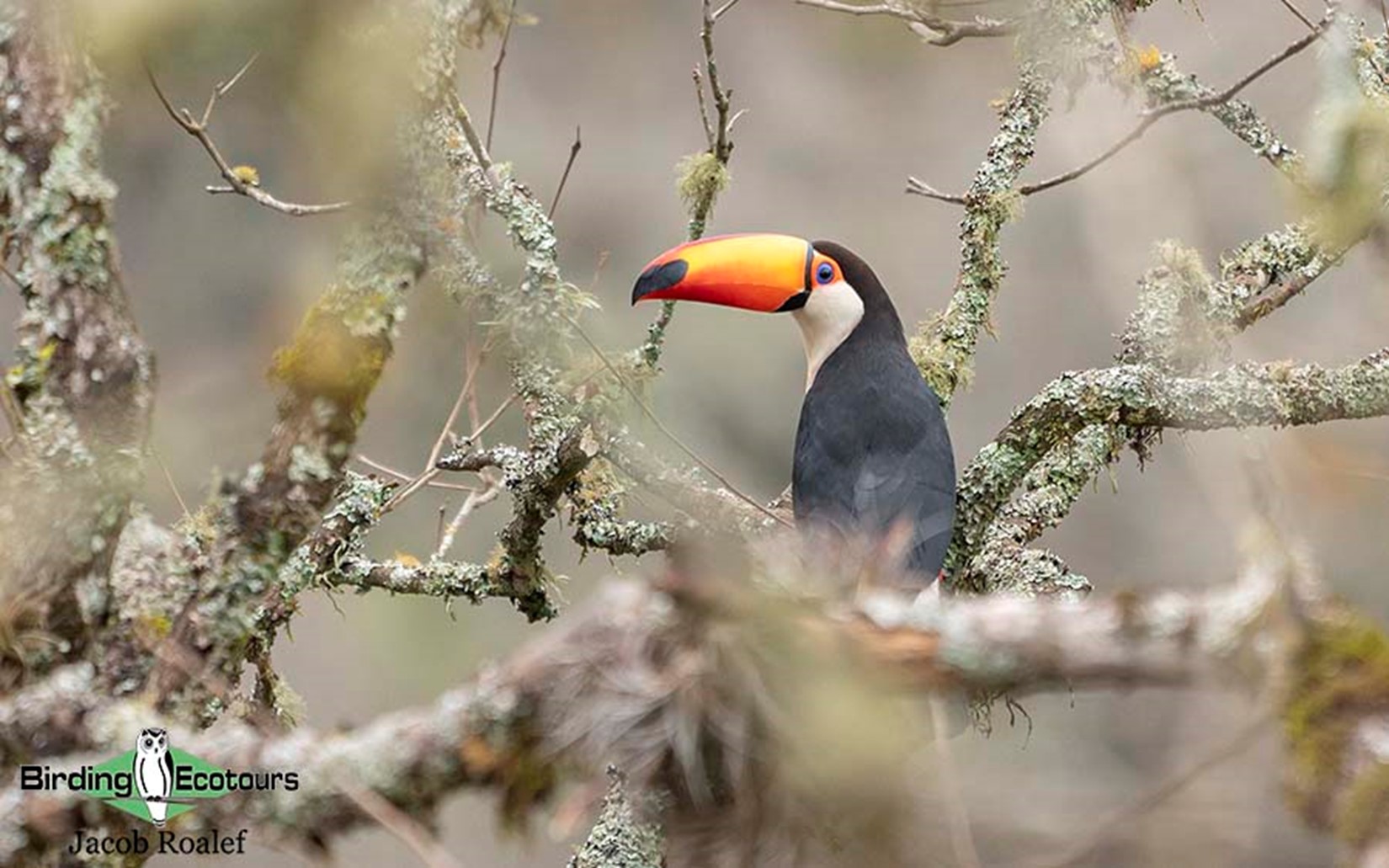
Day 10, 19th October 2022. Dry Chaco Forest to Lozano
We headed off this morning to explore some dry Chaco habitat before making the two and a half hour journey to Lozano, where we would be staying for the next two nights. Our first stop was a bridge overlooking the San Francisco River. This forty-minute stop was full of birds and difficult to tear ourselves away from. Some highlights included White-collared Swift, Sooty Tyrannulet, Yellow-billed Cardinal, Fork-tailed Flycatcher, Large Elaenia and Glittering-bellied Emerald. A Grey-cowled Wood Rail came out from the bush and began foraging around some cow pies, causing a lot of laughter. We then headed into the Chaco. This dirt road held several new targets for us. It didn’t take long before we managed fantastic views of one of these, the Red-billed Scythebill, a bird that almost doesn’t make any sense in terms of how it can exist. We also had fantastic looks at many old and new species during our time here, including Blue-tufted Starthroat, Variable Antshrike, Black-backed Water-Tyrant, Sick’s Swift and Ringed Teal. We went back to Lozano to check in, have lunch, and a little rest before doing some more afternoon and evening birding.
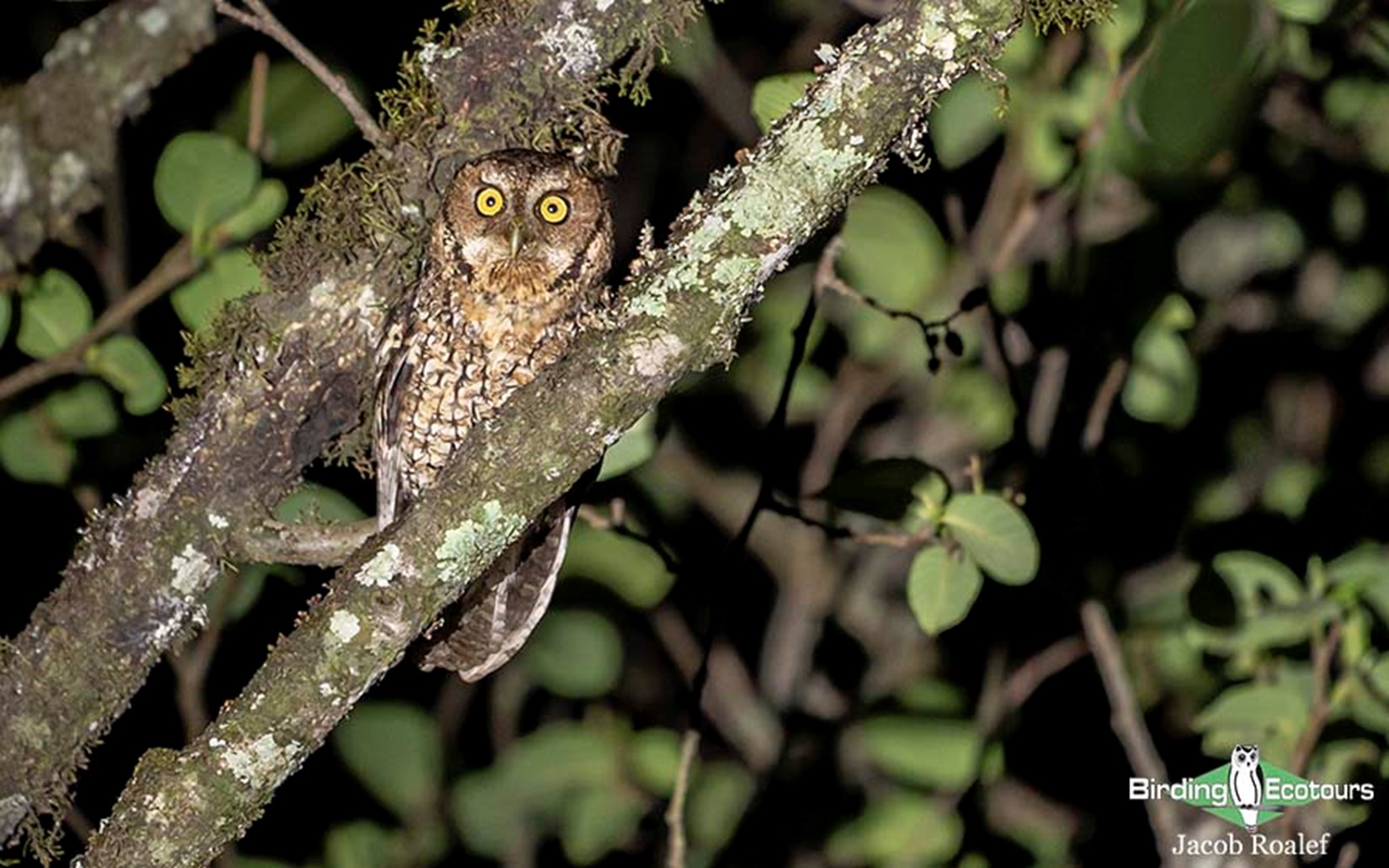
A quick walk around the hotel grounds netted us a new species in the form of Variegated Flycatcher. We then loaded up into the van and headed for Potrero de Yala Provincial Park. Almost immediately upon entry, Diego spotted a top target, Red-faced Guan! A pair of these birds were sitting quietly in a tree, which allowed us some incredible close-up views. We continued walking along the road and picked up more species, like Brown-capped Whitestart, Mountain Wren and Moss-backed Sparrow. We continued to the section of the river where we waited for nightfall to search for nocturnal species. While we waited, we were treated to an incredible show of a Rufous-throated Dipper and then a whole family of Torrent Ducks swimming upstream together. It was one of those truly breathtaking moments. After the sun set, we began to listen and search. A few brief calls of Lyre-tailed Nightjar were heard off in the distance. Then we heard a Montane Forest Screech Owl give some calls and we managed to track it down in a tree. We got a spotlight on it briefly, although long enough for stellar views for the whole group! This extremely range-restricted species was certainly a cherry on top of an excellent day. We headed back to Lozano where we enjoyed a truly delicious dinner together.
Day 11, 20th October 2022. Potrero de Yala Provincial Park
We had the entire day to explore Potrero Yala Provincial Park. The weather was cool and, although there was some fog, this was manageable, and it eventually turned into a lovely day. We started out with a quick scan around one of the high-altitude lakes and saw White-backed Stilt, Yellow-billed Pintail and White-winged Coot. A Bicolored Hawk zoomed by and perched nicely for us in a nearby tree. A small group of Plain-colored Seedeaters put on a nice show and a Smoke-colored Pewee foraged around a nearby building. From the water, we walked around this huge park and picked up several nice species, including Spot-breasted Thornbird, Fulvous-headed Brushfinch and White-crested Elaenia.
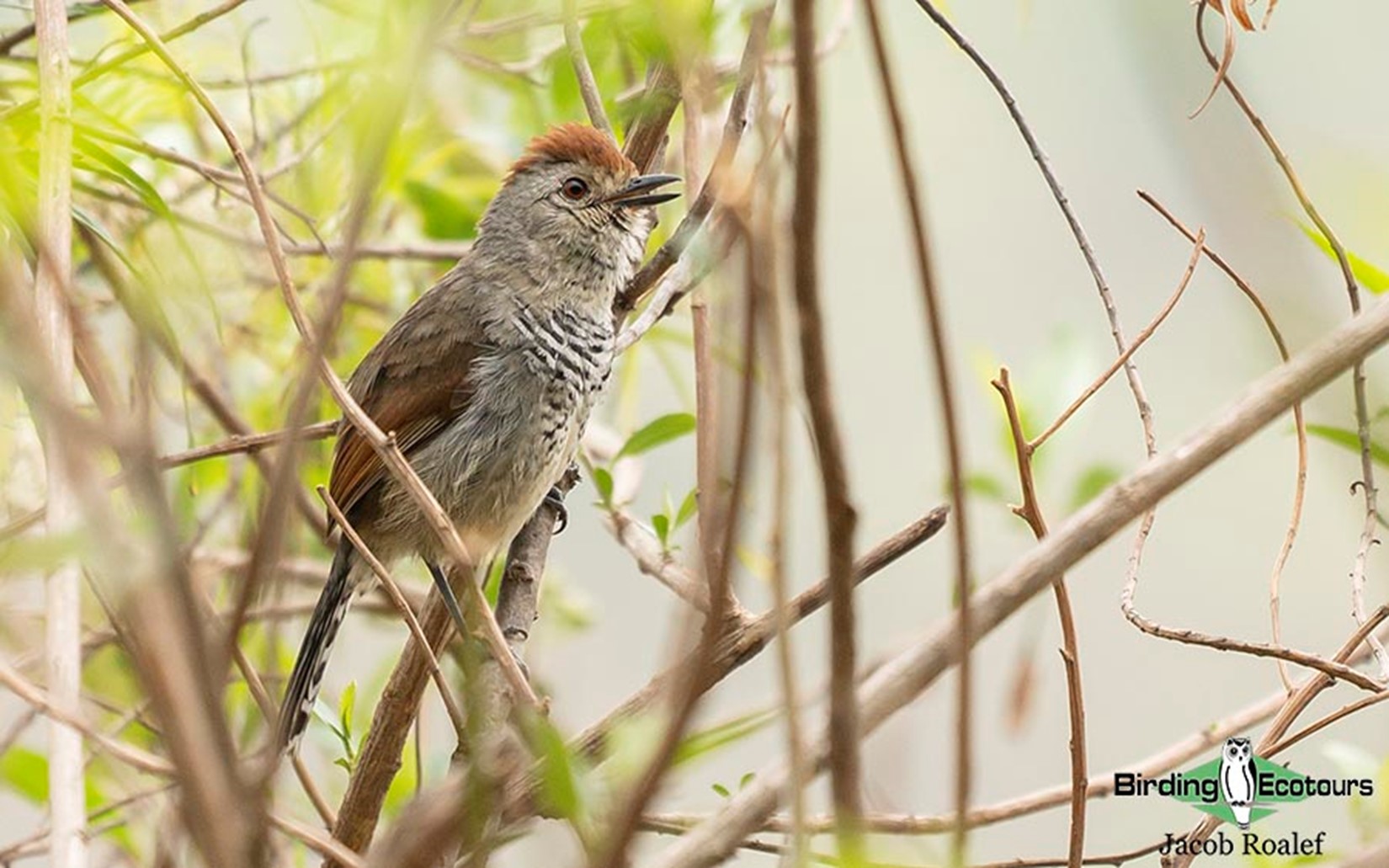
We moved out of the bush and down to another high-altitude lake. Here we heard two different antshrike species calling in two different directions. First it was the Giant Antshrike, which despite its large size, can be incredibly difficult to spot in the understory. After some effort we all managed views of this incredible bird. Next up was the Rufous-capped Antshrike. Luckily this one was much easier and gave us some incredible views along the roadside. After scanning the lake, we picked up several nice species like Puna Ibis, Andean Gull, Neotropic Cormorant and Wattled Jacana. We headed back to town to grab some lunch before spending the remainder of the afternoon working our way down the slope. The birding slowed down from the morning, but the scenery was lovely. A highlight was an incredible pair of Cream-backed Woodpeckers that worked their way down the hill with us. Also amazing were a soaring Roadside Hawk, a striking Fawn-breasted Tanager and a clicking Golden-winged Cacique inside some dense bushes. It was then time for another spectacular dinner near our hotel in Lozano.
Day 12, 21st October 2022. Purmamarca to Tilcara
This was mostly a travel, rest, and cultural day, but of course there was some nice birding as well. After breakfast we made our way to the town of Purmamarca and saw The Hill of Seven Colors, one of the great wonders of Argentina! We birded on one of the trails and saw our first Brown-backed Mockingbird, along with Creamy-breasted Canastero, Greenish Yellow-Finch, Andean Swift and Black-chested Buzzard-Eagle. We then explored the town and some of the tourist shops before sitting down for lunch. While eating we were joined by a new trip bird, Black-hooded Sierra Finch, wanting the same lunch as us! After savoring the scenery for the last time, we loaded up and headed towards Tilcara and checked into our hotel. We all decided to have a break and enjoyed some time at the incredible hotel. In the late afternoon we ventured out and explored the Pucará de Tilcara, nearby pre-Inca ruins. The wind was strong, and the birds were virtually non-existent, except for a wind-blown Barn Swallow and some singing House Wrens. We headed back to the hotel and enjoyed a tasty dinner there.
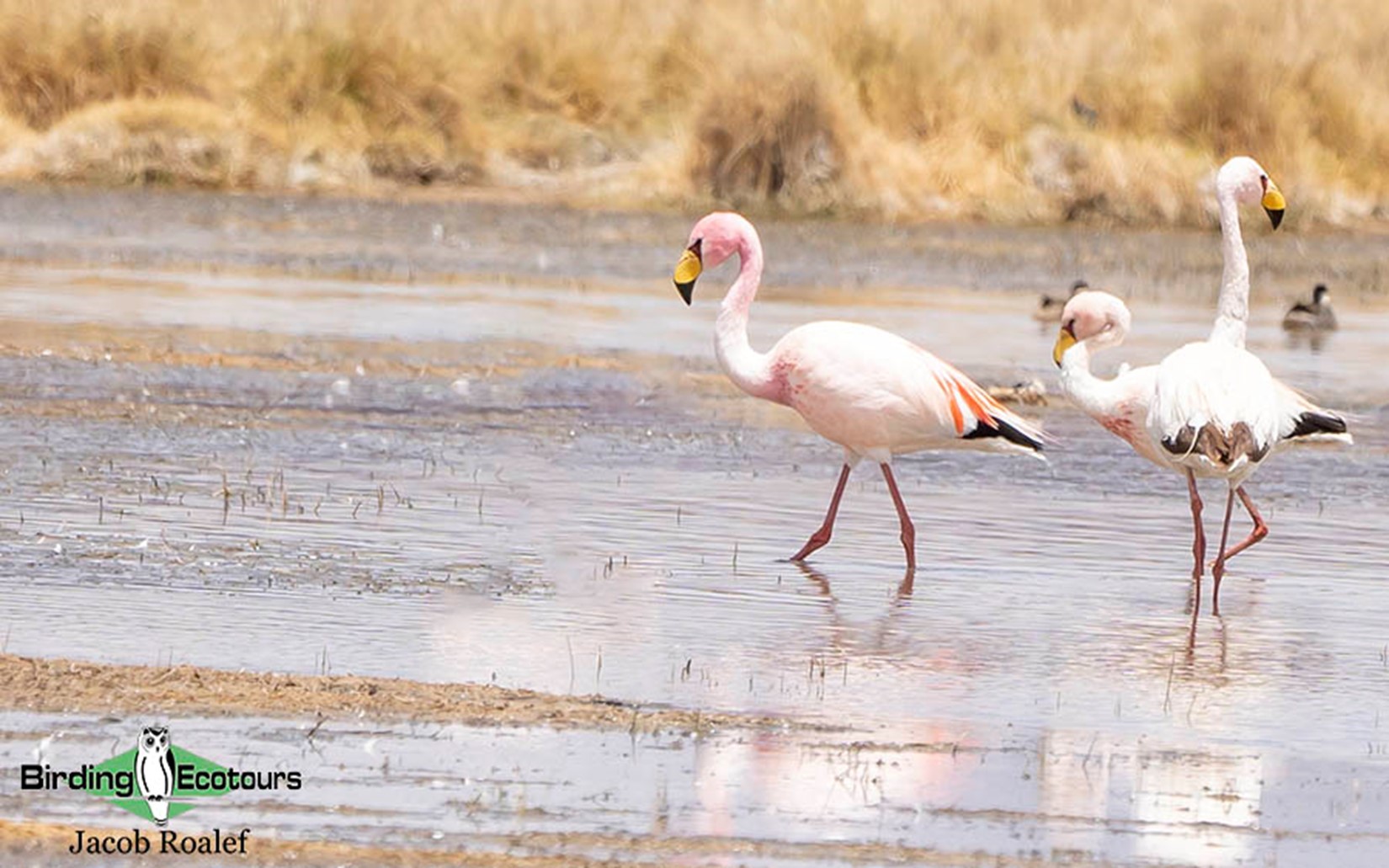
Day 13, 22nd October 2022. Lakes around Abra Pampa
Our schedule for the day was jam-packed, as we had a lot of driving and birding to squeeze in. We headed out hastily after breakfast and made our way to Laguna de Huancar. This small lake is located right next to a popular sand skiing slope just south of Abra Pampa. We experienced our first taste of high Puna wetland birding, with species like Giant Coot, Silvery Grebe, Andean and Crested Ducks and Puna Teal. Then we made our way into Abra Pampa and checked out some local football (soccer) fields where we quickly scored our target, Bright-rumped Yellow-Finch. It was time for a nice lunch in the town square area since it was a beautiful day for a picnic.
After lunch we had a few more bodies of water to check out. First up was a small pond just north of Abra Pampa that was full of birds. We managed fantastic views of both James’s and Chilean Flamingos along with Andean Goose, Crested Duck, White-cheeked Pintail, Wilson’s Phalarope, Andean Lapwing and Puna Ibis plus many others. The surrounding grasslands held Andean Negrito, Puna Miner and Ash-breasted Sierra Finch. We managed to dodge an interesting encounter with a cow and guaco before moving to the next location, Laguna Runtuyoc. After a brief hike, we managed to get close to the water and scored our third flamingo of the day, Andean Flamingo! We all celebrated this sweep. In addition to the flamingos, there were Inca Teal and Common Miner. We also noted our first of many Vicunas, a high-altitude llama-like mammal. It was time to move along and head even higher in altitude. As we approached Yavi, we took in the scenic views and spotted a Mountain Caracara along the roadside. We arrived at the tiny village for dinner and a good night’s sleep after the long day of travel and birding.
Day 14, 23rd October 2022. Yavi area birding
We headed out for a short hike right outside our lodge before breakfast. (This activity was repeated for the next three mornings.) We were at a very high altitude, about 11,320 feet (3,450 m), so we moved slower and noted the different avian assemblage. Right away we were treated to a large flock of Citron-headed Yellow-Finches, one of the top targets for this location. Mixed in with these finches were Diuca Finch, Band-tailed Seedeater, Golden-billed Saltator, Black-hooded Sierra Finch and Grey-hooded Parakeet. As we continued along the trail we spotted the other top target, Wedge-tailed Hillstar, whose green gorget glowed brilliantly in the morning sun! We hiked back up and had our breakfast and coffee before setting off again to explore more areas surrounding Yavi.
Mid-morning into early afternoon was spent hiking along a small stream that ran through the outskirts of town. We tallied up a nice list of over 30 species whilst going slowly and steadily. Top highlights from this adventure were Bare-faced Ground Dove, Giant Hummingbird, Cream-winged and White-winged Cinclodes, Streak-fronted Thornbird, Cliff Flycatcher, and Rufous-sided Warbling Finch. Just before we made it back to town, we spotted an Andean Tinamou scurrying off into the tall grasses and had a gorgeous Mountain Caracara soaring by overhead. It was time for lunch and a small rest. For the late afternoon, we headed to Yavi Chico, a small version of Yavi nearby. The top highlight here was d’Orbigny’s Chat-Tyrant, a new species for the trip, and we also enjoyed Rock Earthcreeper, Spot-winged Pigeon, and Andean Swift. It was time to head back for dinner with our hosts, who now felt like friends, Magui and her family. Another great day successfully completed.
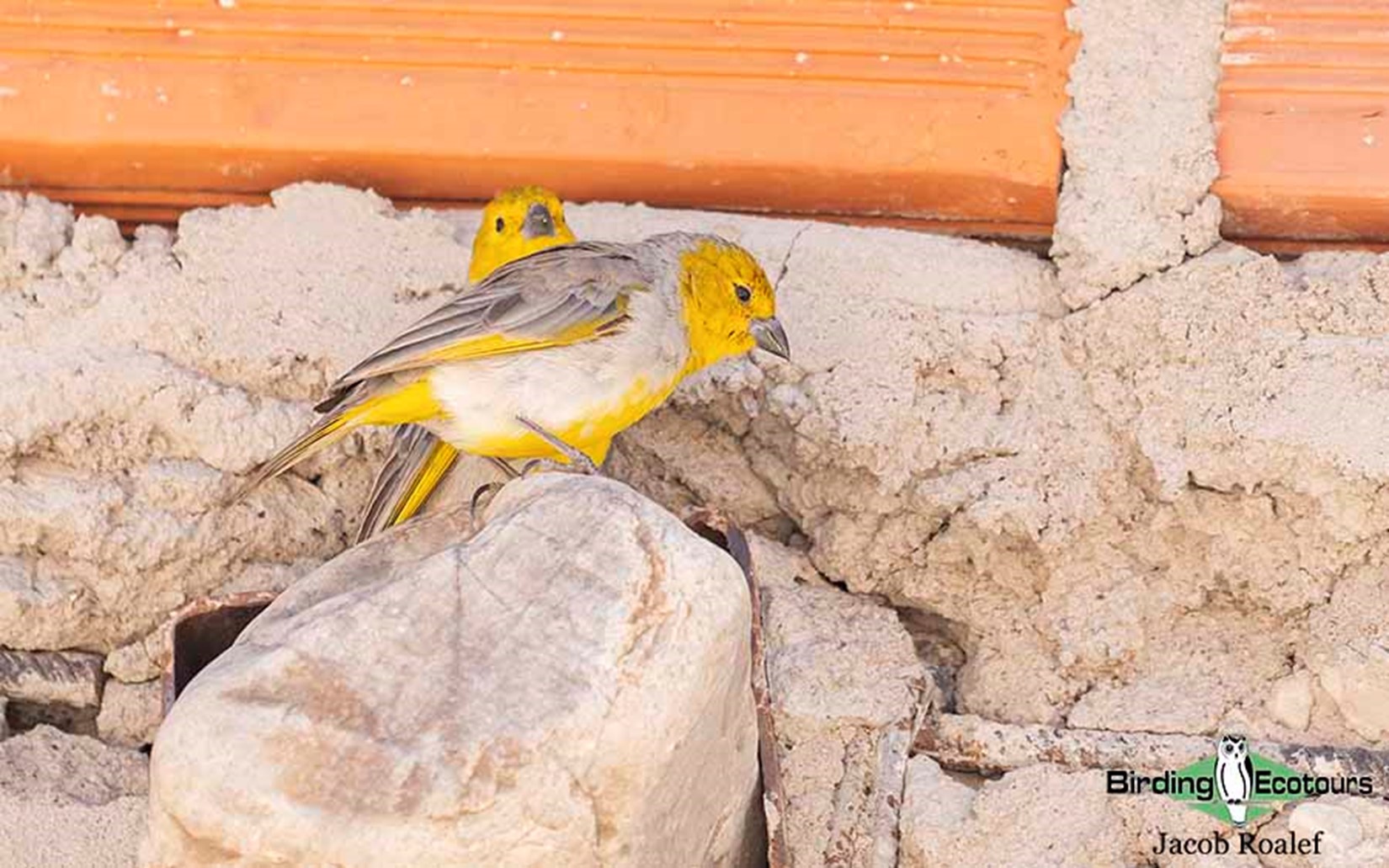
Day 15, 24th October 2022. High Puna and Lizoite Vega
Like the previous morning, we started with a short hike before breakfast and saw the brilliant Citron-headed Yellow-Finch and Wedge-tailed Hillstar. If we did this every morning for a year, we would not get tired of seeing these amazing species! In addition to the typical species, we added a new trip bird in the form of Aplomado Falcon. After breakfast, we began our journey to even higher altitudes! Along the drive we saw many Vicunas plus a pair of sneaky Ornate Tinamous and an uncooperative flock of Mountain Parakeets. We eventually reached the pass of Abra de Lizoite at a staggering 14,950 feet (4,555 m), which is higher than any peak in the continental USA! Although cold and windy at these heights, the panorama was magnificent and awe-inspiring, especially when an Andean Condor soared overhead.
We descended slightly, but not much, to Lizoite Vega, a small stream running through the valley and creating some wetland-type habitat. Thankfully it didn’t take long before we were all on the top target, the Diademed Sandpiper-Plover. This was a stunning and incredible bird indeed! We continued birding here and picked up another extreme high-altitude specialist, the Red-backed Sierra Finch. After a picnic lunch, we took a short walk to explore downstream and had some incredible views of a pair of Diademed Sandpiper-Plovers working the water. While these rare plovers were the stars, we nevertheless enjoyed the other species, like Andean Flicker, Straight-billed Earthcreeper, Andean Swallow and Cinerous Ground-Tyrant. After an excellent afternoon, we made our way back to Yavi. After such high altitudes, we all needed a rest before heading out for our final dinner in the northwest provinces of Argentina.
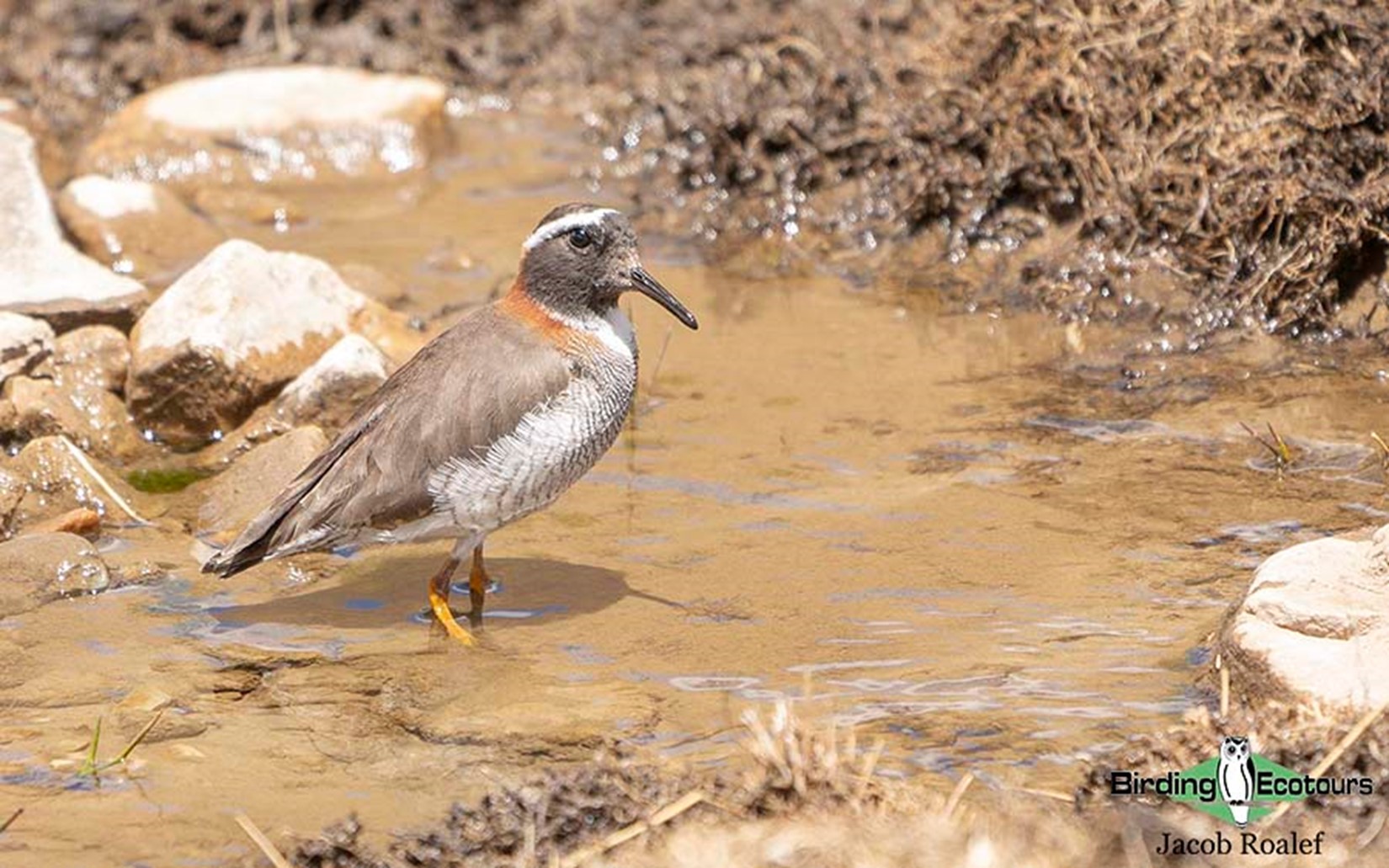
Day 16, 25th October 2022. Transfer to Jujuy and flight back to Buenos Aires
We enjoyed our final walk in the high Puna area surrounding Javi and took last looks at species here, including Citron-headed Yellow-Finch, Diuca Finch, Brown-backed Mockingbird and Wedge-tailed Hillstar. After this, we had breakfast and coffee before packing our bags and beginning the long drive back to Jujuy. We made a stop for about an hour outside Abra Pampa. This small pond mostly had the same species we had seen on our first visit, but we enjoyed good views of James’s and Chilean Flamingos, Crested Duck, Andean Goose, Inca Teal, Andean Negrito, and Puna Ibis. As we stared at the water, we noticed a small songbird flying around, Band-tailed Sierra Finch, a new species for the trip! After a long drive, we caught our flight back to Buenos Aires, where we grabbed dinner and went to bed.
Day 17, 26th October 2022. Costanera Sur Ecological Reserve
Due to our late flight and dinner the previous night, we slept in a little this morning. After a lovely breakfast at the hotel, we grabbed our gear and headed out for some birding. The weather forecast for the day was a bit “iffy”, and because of the rain overnight, the main entrance to Costanera Sur was closed for the day. Nevertheless, we had a beautiful time outside the park, looking into the amazing ponds and wetlands. Close-up views of many species were had, including Southern Screamer, Wattled Jacana, Black-necked Swan, Silver Teal, White-winged Coot, Spot-flanked Gallinule and Rosy-billed Pochard. Then we headed to a nearby local park and picked up some nice birds, like Vermillion Flycatcher, Monk and Nanday Parakeets, Chimango Caracara, and Creamy-bellied Thrush. Towards the end of our time at the park the wind and rain started to pick up, so we headed for lunch and rested in the afternoon.
Day 18, 27th October 2022. More Costanera Sur before departure
On our final day together, we decided to head back to Costanera Sur before our evening flights home. Luckily the park was open, and we got to enjoy the wonders of this gem located right in the heart of Buenos Aires. Two and a half hours later we had tallied a list of 61 species, including several new species for the trip: White-faced Whistling-Duck, Black-headed, Masked and Lake Ducks, Small-billed Elaenia, and Streaked Flycatcher. Of course, in addition to the new species added, we enjoyed our wonderful time here with other species like Masked Gnatcatcher, Rufous-bellied Thrush, Chivi Vireo, Tropical Parula, and many others. We headed back to the hotel, had lunch, and went to the airport. We discussed our favorite species for the trip, and the following were the top five for the group, in no order: Red-legged Seriema, Diademed Sandpiper-Plover, James’s Flamingo, Sandy Gallito and Torrent Duck. It was truly a splendid trip, full of birds, scenery, food, culture and laughter.
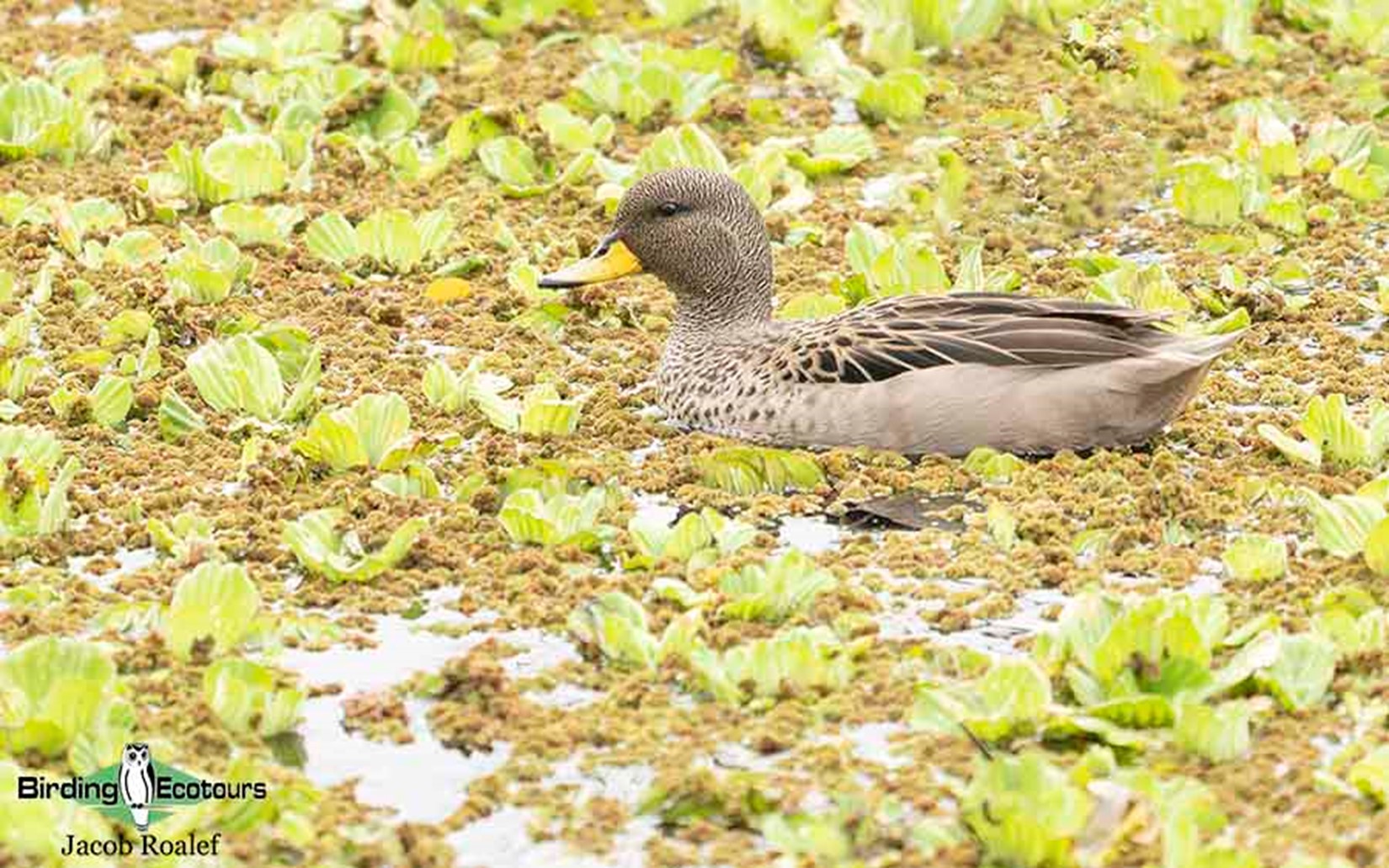
Bird List – Following IOC (12.2)
Birds ‘heard only’ are marked with (H) after the common name, all other species were seen. Species seen only on the pre-trip day of this trip are marked with (+) after the common name.
The following notation after species names is used to show conservation status following BirdLife International: CE = Critically Endangered, EN = Endangered, VU = Vulnerable, NT = Near Threatened.
| Common Name | Scientific Name |
| Tinamous (Tinamidae) | |
| Ornate Tinamou | Nothoprocta ornata |
| Brushland Tinamou | Nothoprocta cinerascens |
| Andean Tinamou | Nothoprocta pentlandii |
| Screamers (Anhimidae) | |
| Southern Screamer | Chauna torquata |
| Ducks, Geese, Swans (Anatidae) | |
| White-faced Whistling Duck | Dendrocygna viduata |
| Coscoroba Swan | Coscoroba coscoroba |
| Black-necked Swan | Cygnus melancoryphus |
| Torrent Duck | Merganetta armata |
| Andean Goose | Chloephaga melanoptera |
| Muscovy Duck | Cairina moschata |
| Brazilian Teal | Amazonetta brasiliensis |
| Ringed Teal | Callonetta leucophrys |
| Crested Duck | Lophonetta specularioides |
| Puna Teal | Spatula puna |
| Silver Teal | Spatula versicolor |
| Red Shoveler | Spatula platalea |
| Cinnamon Teal | Spatula cyanoptera |
| White-cheeked Pintail | Anas bahamensis |
| Yellow-billed Pintail | Anas georgica |
| Yellow-billed Teal (Inca Teal) | Anas flavirostris |
| Rosy-billed Pochard | Netta peposaca |
| Black-headed Duck | Heteronetta atricapilla |
| Masked Duck | Nomonyx dominicus |
| Andean Duck | Oxyura ferruginea |
| Lake Duck | Oxyura vittata |
| Chachalacas, Curassows, Guans (Cracidae) | |
| Chaco Chachalaca | Ortalis canicollis |
| Red-faced Guan | Penelope dabbenei |
| Yungas Guan | Penelope bridgesi |
| Nightjars (Caprimulgidae) | |
| Lyre-tailed Nightjar (H) | Uropsalis lyra |
| Swifts (Apodidae) | |
| White-collared Swift | Streptoprocne zonaris |
| Sick’s Swift | Chaetura meridionalis |
| Andean Swift | Aeronautes andecolus |
| Hummingbirds (Trochilidae) | |
| Sparkling Violetear | Colibri coruscans |
| Speckled Hummingbird | Adelomyia melanogenys |
| Red-tailed Comet | Sappho sparganurus |
| Wedge-tailed Hillstar | Oreotrochilus adela |
| Blue-capped Puffleg | Eriocnemis glaucopoides |
| Giant Hummingbird | Patagona gigas |
| Blue-tufted Starthroat | Heliomaster furcifer |
| Glittering-bellied Emerald | Chlorostilbon lucidus |
| Gilded Sapphire | Hylocharis chrysura |
| White-bellied Hummingbird | Elliotomyia chionogaster |
| Cuckoos (Cuculidae) | |
| Guira Cuckoo | Guira guira |
| Pigeons, Doves (Columbidae) | |
| Rock Dove (Introduced) | Columba livia |
| Picazuro Pigeon | Patagioenas picazuro |
| Spot-winged Pigeon | Patagioenas maculosa |
| Picui Ground Dove | Columbina picui |
| Bare-faced Ground Dove | Metriopelia ceciliae |
| Moreno’s Ground Dove (Endemic) | Metriopelia morenoi |
| Black-winged Ground Dove | Metriopelia melanoptera |
| White-tipped Dove | Leptotila verreauxi |
| Eared Dove | Zenaida auriculata |
| Rails, Crakes & Coots (Rallidae) | |
| Plumbeous Rail | Pardirallus sanguinolentus |
| Grey-cowled Wood Rail | Aramides cajaneus |
| Giant Wood Rail | Aramides ypecaha |
| Spot-flanked Gallinule | Porphyriops melanops |
| Common Gallinule | Gallinula galeata |
| Red-fronted Coot | Fulica rufifrons |
| Giant Coot | Fulica gigantea |
| Red-gartered Coot | Fulica armillata |
| Andean Coot | Fulica ardesiaca |
| White-winged Coot | Fulica leucoptera |
| Limpkin (Aramidae) | |
| Limpkin | Aramus guarauna |
| Grebes (Podicipedidae) | |
| Pied-billed Grebe | Podilymbus podiceps |
| White-tufted Grebe | Rollandia rolland |
| Great Grebe | Podiceps major |
| Silvery Grebe | Podiceps occipitalis |
| Flamingos (Phoenicopteridae) | |
| Chilean Flamingo | Phoenicopterus chilensis |
| Andean Flamingo – VU | Phoenicoparrus andinus |
| James’s Flamingo | Phoenicoparrus jamesi |
| Stilts, Avocets (Recurvirostridae) | |
| White-backed Stilt | Himantopus melanurus |
| Andean Avocet | Recurvirostra andina |
| Plovers (Charadriidae) | |
| Southern Lapwing | Vanellus chilensis |
| Andean Lapwing | Vanellus resplendens |
| Diademed Sandpiper-Plover | Phegornis mitchellii |
| Jacanas (Jacanidae) | |
| Wattled Jacana | Jacana jacana |
| Seedsnipes (Thinocoridae) | |
| Grey-breasted Seedsnipe | Thinocorus orbignyianus |
| Sandpipers, Snipes (Scolopacidae) | |
| Hudsonian Godwit | Limosa haemastica |
| Baird’s Sandpiper | Calidris bairdii |
| Pectoral Sandpiper | Calidris melanotos |
| Pantanal Snipe | Gallinago paraguaiae |
| Wilson’s Phalarope | Phalaropus tricolor |
| Spotted Sandpiper | Actitis macularius |
| Solitary Sandpiper | Tringa solitaria |
| Lesser Yellowlegs | Tringa flavipes |
| Greater Yellowlegs | Tringa melanoleuca |
| Gulls, Terns, Skimmers (Laridae) | |
| Andean Gull | Chroicocephalus serranus |
| Brown-hooded Gull | Chroicocephalus maculipennis |
| Grey-headed Gull | Chroicocephalus cirrocephalus |
| Snowy-crowned Tern | Sterna trudeaui |
| Storks (Ciconiidae) | |
| Maguari Stork | Ciconia maguari |
| Cormorants, Shags (Phalacrocoracidae) | |
| Neotropic Cormorant | Nannopterum brasilianum |
| Ibises, Spoonbills (Threskiornithidae) | |
| Buff-necked Ibis | Theristicus caudatus |
| Bare-faced Ibis | Phimosus infuscatus |
| White-faced Ibis | Plegadis chihi |
| Puna Ibis | Plegadis ridgwayi |
| Roseate Spoonbill | Platalea ajaja |
| Herons, Bitterns (Ardeidae) | |
| Rufescent Tiger Heron | Tigrisoma lineatum |
| Black-crowned Night Heron | Nycticorax nycticorax |
| Western Cattle Egret | Bubulcus ibis |
| Cocoi Heron | Ardea cocoi |
| Great Egret | Ardea alba |
| Whistling Heron | Syrigma sibilatrix |
| Snowy Egret | Egretta thula |
| New World Vultures (Cathartidae) | |
| Andean Condor – VU | Vultur gryphus |
| Black Vulture | Coragyps atratus |
| Turkey Vulture | Cathartes aura |
| Kites, Hawks, Eagles (Accipitridae) | |
| Swallow-tailed Kite | Elanoides forficatus |
| Bicolored Hawk | Accipiter bicolor |
| Long-winged Harrier | Circus buffoni |
| Plumbeous Kite | Ictinia plumbea |
| Snail Kite | Rostrhamus sociabilis |
| Crane Hawk | Geranospiza caerulescens |
| Savanna Hawk | Buteogallus meridionalis |
| Great Black Hawk | Buteogallus urubitinga |
| Roadside Hawk | Rupornis magnirostris |
| Harris’s Hawk | Parabuteo unicinctus |
| Variable Hawk | Geranoaetus polyosoma |
| Black-chested Buzzard-Eagle | Geranoaetus melanoleucus |
| Owls (Strigidae) | |
| Burrowing Owl | Athene cunicularia |
| Yungas Screech Owl | Megascops hoyi |
| Trogons (Trogonidae) | |
| Blue-crowned Trogon | Trogon curucui |
| Kingfishers (Alcedinidae) | |
| Ringed Kingfisher | Megaceryle torquata |
| Puffbirds (Bucconidae) | |
| Chaco Puffbird | Nystalus striatipectus |
| Toucans (Ramphastidae) | |
| Toco Toucan | Ramphastos toco |
| Woodpeckers (Picidae) | |
| White-barred Piculet | Picumnus cirratus |
| White Woodpecker | Melanerpes candidus |
| White-fronted Woodpecker | Melanerpes cactorum |
| Dot-fronted Woodpecker | Veniliornis frontalis |
| Checkered Woodpecker | Veniliornis mixtus |
| Golden-olive Woodpecker | Colaptes rubiginosus |
| Green-barred Woodpecker | Colaptes melanochloros |
| Andean Flicker | Colaptes rupicola |
| Cream-backed Woodpecker | Campephilus leucopogon |
| Seriemas (Cariamidae) | |
| Red-legged Seriema | Cariama cristata |
| Black-legged Seriema | Chunga burmeisteri |
| Caracaras, Falcons (Falconidae) | |
| Mountain Caracara | Phalcoboenus megalopterus |
| Crested Caracara | Caracara plancus |
| Chimango Caracara | Milvago chimango |
| American Kestrel | Falco sparverius |
| Aplomado Falcon | Falco femoralis |
| Peregrine Falcon | Falco peregrinus |
| African & New World Parrots (Psittacidae) | |
| Grey-hooded Parakeet | Psilopsiagon aymara |
| Mountain Parakeet | Psilopsiagon aurifrons |
| Monk Parakeet | Myiopsitta monachus |
| Yellow-chevroned Parakeet | Brotogeris chiriri |
| Scaly-headed Parrot | Pionus maximiliani |
| Tucuman Amazon – VU | Amazona tucumana |
| Turquoise-fronted Amazon | Amazona aestiva |
| Maroon-bellied Parakeet | Pyrrhura frontalis |
| Green-cheeked Parakeet | Pyrrhura molinae |
| Burrowing Parrot | Cyanoliseus patagonus |
| Nanday Parakeet | Aratinga nenday |
| Golden-collared Macaw | Primolius auricollis |
| Blue-crowned Parakeet | Thectocercus acuticaudatus |
| Mitred Parakeet | Psittacara mitratus |
| White-eyed Parakeet | Psittacara leucophthalmus |
| Ovenbirds (Furnariidae) | |
| Common Miner | Geositta cunicularia |
| Puna Miner | Geositta punensis |
| Rufous-banded Miner | Geositta rufipennis |
| Olivaceous Woodcreeper | Sittasomus griseicapillus |
| Red-billed Scythebill | Campylorhamphus trochilirostris |
| Narrow-billed Woodcreeper | Lepidocolaptes angustirostris |
| Streaked Xenops | Xenops rutilans |
| Straight-billed Earthcreeper | Ochetorhynchus ruficaudus |
| Rock Earthcreeper | Ochetorhynchus andaecola |
| Chaco Earthcreeper | Tarphonomus certhioides |
| Rufous Hornero | Furnarius rufus |
| Buff-breasted Earthcreeper | Upucerthia validirostris |
| Cream-winged Cinclodes | Cinclodes albiventris |
| White-winged Cinclodes | Cinclodes atacamensis |
| Buff-browed Foliage-gleaner | Syndactyla rufosuperciliata |
| Brown-capped Tit-Spinetail | Leptasthenura fuliginiceps |
| Tufted Tit-Spinetail | Leptasthenura platensis |
| Plain-mantled Tit-Spinetail | Leptasthenura aegithaloides |
| Rufous-fronted Thornbird | Phacellodomus rufifrons |
| Streak-fronted Thornbird | Phacellodomus striaticeps |
| Little Thornbird | Phacellodomus sibilatrix |
| Spot-breasted Thornbird | Phacellodomus maculipectus |
| Freckle-breasted Thornbird | Phacellodomus striaticollis |
| Firewood-gatherer | Anumbius annumbi |
| Lark-like Brushrunner | Coryphistera alaudina |
| Rusty-vented Canastero | Asthenes dorbignyi |
| Short-billed Canastero | Asthenes baeri |
| Puna Canastero | Asthenes sclateri |
| Cordilleran Canastero | Asthenes modesta |
| Maquis Canastero | Asthenes heterura |
| Sulphur-bearded Reedhaunter | Limnoctites sulphuriferus |
| Stripe-crowned Spinetail | Cranioleuca pyrrhophia |
| Steinbach’s Canastero (Endemic) | Pseudasthenes steinbachi |
| Brown Cacholote | Pseudoseisura lophotes |
| White-throated Cacholote (Endemic) | Pseudoseisura gutturalis |
| Yellow-chinned Spinetail | Certhiaxis cinnamomeus |
| Chotoy Spinetail | Schoeniophylax phryganophilus |
| Pale-breasted Spinetail | Synallaxis albescens |
| Sooty-fronted Spinetail | Synallaxis frontalis |
| Azara’s Spinetail | Synallaxis azarae |
| Antbirds (Thamnophilidae) | |
| Black-capped Antwren | Herpsilochmus atricapillus |
| Variable Antshrike | Thamnophilus caerulescens |
| Rufous-capped Antshrike | Thamnophilus ruficapillus |
| Giant Antshrike | Batara cinerea |
| Tapaculos (Rhinocryptidae) | |
| Sandy Gallito (Endemic) | Teledromas fuscus |
| White-browed Tapaculo (Endemic) | Scytalopus superciliaris |
| Tyrant Flycatchers, Calyptura (Tyrannidae) | |
| Sclater’s Tyrannulet | Phyllomyias sclateri |
| Grey Elaenia | Myiopagis caniceps |
| Large Elaenia | Elaenia spectabilis |
| Chilean Elaenia | Elaenia chilensis |
| Small-billed Elaenia | Elaenia parvirostris |
| Slaty Elaenia | Elaenia strepera |
| Highland Elaenia | Elaenia obscura |
| Southern Beardless Tyrannulet | Camptostoma obsoletum |
| Suiriri Flycatcher | Suiriri suiriri |
| White-throated Tyrannulet | Mecocerculus leucophrys |
| Buff-banded Tyrannulet | Mecocerculus hellmayri |
| Yellow-billed Tit-Tyrant | Anairetes flavirostris |
| Tufted Tit-Tyrant | Anairetes parulus |
| Sooty Tyrannulet | Serpophaga nigricans |
| White-crested Tyrannulet | Serpophaga subcristata |
| White-bellied Tyrannulet | Serpophaga munda |
| Warbling Doradito | Pseudocolopteryx flaviventris |
| Fulvous-crowned Scrub Tyrant | Euscarthmus meloryphus |
| Greater Wagtail-Tyrant | Stigmatura budytoides |
| Mottle-cheeked Tyrannulet | Phylloscartes ventralis |
| Pearly-vented Tody-Tyrant | Hemitriccus margaritaceiventer |
| Ochre-faced Tody-Flycatcher | Poecilotriccus plumbeiceps |
| Yellow-olive Flatbill | Tolmomyias sulphurescens |
| Cliff Flycatcher | Hirundinea ferruginea |
| Euler’s Flycatcher | Lathrotriccus euleri |
| Black Phoebe | Sayornis nigricans |
| Smoke-colored Pewee | Contopus fumigatus |
| Scarlet Flycatcher (Vermilion) | Pyrocephalus rubinus |
| Yellow-browed Tyrant | Satrapa icterophrys |
| Cinereous Ground Tyrant | Muscisaxicola cinereus |
| White-browed Ground-Tyrant | Muscisaxicola albilora |
| Andean Negrito | Lessonia oreas |
| Spectacled Tyrant | Hymenops perspicillatus |
| Plumbeous Tyrant | Knipolegus cabanisi |
| White-winged Black Tyrant | Knipolegus aterrimus |
| White Monjita | Xolmis irupero |
| Black-crowned Monjita | Neoxolmis coronatus |
| Black-billed Shrike-Tyrant | Agriornis montanus |
| Black-backed Water Tyrant | Fluvicola albiventer |
| D’Orbigny’s Chat-Tyrant | Ochthoeca oenanthoides |
| White-browed Chat-Tyrant | Ochthoeca leucophrys |
| Cattle Tyrant | Machetornis rixosa |
| Piratic Flycatcher | Legatus leucophaius |
| Great Kiskadee | Pitangus sulphuratus |
| Streaked Flycatcher | Myiodynastes maculatus |
| Variegated Flycatcher | Empidonomus varius |
| Crowned Slaty Flycatcher | Griseotyrannus aurantioatrocristatus |
| Tropical Kingbird | Tyrannus melancholicus |
| Fork-tailed Flycatcher | Tyrannus savana |
| Dusky-capped Flycatcher | Myiarchus tuberculifer |
| Cotingas (Cotingidae) | |
| White-tipped Plantcutter | Phytotoma rutila |
| Manakins (Pipridae) | |
| Yungas Manakin | Chiroxiphia boliviana |
| Tityras, Becards, Sharpbill (Tityridae) | |
| White-naped Xenopsaris | Xenopsaris albinucha |
| Vireos, Greenlets, Shrike-babblers (Vireonidae) | |
| Chivi Vireo | Vireo chivi |
| Crows, Jays (Corvidae) | |
| Plush-crested Jay | Cyanocorax chrysops |
| Swallows, Martins (Hirundinidae) | |
| White-rumped Swallow | Tachycineta leucorrhoa |
| Blue-and-white Swallow | Pygochelidon cyanoleuca |
| Tawny-headed Swallow | Alopochelidon fucata |
| Andean Swallow | Orochelidon andecola |
| Southern Rough-winged Swallow | Stelgidopteryx ruficollis |
| Brown-chested Martin | Progne tapera |
| Southern Martin | Progne elegans |
| Grey-breasted Martin | Progne chalybea |
| Barn Swallow | Hirundo rustica |
| American Cliff Swallow | Petrochelidon pyrrhonota |
| Wrens (Troglodytidae) | |
| House Wren | Troglodytes aedon |
| Mountain Wren | Troglodytes solstitialis |
| Gnatcatchers (Polioptilidae) | |
| Masked Gnatcatcher | Polioptila dumicola |
| Mockingbirds, Thrashers (Mimidae) | |
| Chalk-browed Mockingbird | Mimus saturninus |
| Patagonian Mockingbird | Mimus patagonicus |
| White-banded Mockingbird | Mimus triurus |
| Brown-backed Mockingbird | Mimus dorsalis |
| Starlings, Rhabdornis (Sturnidae) | |
| Common Starling (Introduced) | Sturnus vulgaris |
| Thrushes (Turdidae) | |
| Speckled Nightingale-Thrush | Catharus maculatus |
| Swainson’s Thrush | Catharus ustulatus |
| Chiguanco Thrush | Turdus chiguanco |
| Andean Slaty Thrush | Turdus nigriceps |
| Creamy-bellied Thrush | Turdus amaurochalinus |
| Rufous-bellied Thrush | Turdus rufiventris |
| Dippers (Cinclidae) | |
| Rufous-throated Dipper – VU | Cinclus schulzii |
| Old World Sparrows, Snowfinches (Passeridae) | |
| House Sparrow (Introduced) | Passer domesticus |
| Wagtails, Pipits (Motacillidae) | |
| Hellmayr’s Pipit | Anthus hellmayri |
| Finches, Euphonias (Fringillidae) | |
| Hooded Siskin | Spinus magellanicus |
| Black Siskin | Spinus atratus |
| New World Sparrows (Passerellidae) | |
| Common Bush Tanager | Chlorospingus flavopectus |
| White-browed Brushfinch | Arremon torquatus |
| Moss-backed Sparrow | Arremon dorbignii |
| Rufous-collared Sparrow | Zonotrichia capensis |
| Fulvous-headed Brushfinch | Atlapetes fulviceps |
| Yellow-striped Brushfinch (Endemic) | Atlapetes citrinellus |
| Oropendolas, Orioles, Blackbirds (Icteridae) | |
| Crested Oropendola | Psarocolius decumanus |
| Golden-winged Cacique | Cacicus chrysopterus |
| Variable Oriole | Icterus pyrrhopterus |
| Screaming Cowbird | Molothrus rufoaxillaris |
| Shiny Cowbird | Molothrus bonariensis |
| Scarlet-headed Blackbird | Amblyramphus holosericeus |
| Greyish Baywing | Agelaioides badius |
| Chestnut-capped Blackbird | Chrysomus ruficapillus |
| Yellow-winged Blackbird | Agelasticus thilius |
| Brown-and-yellow Marshbird | Pseudoleistes virescens |
| New World Warblers (Parulidae) | |
| Southern Yellowthroat | Geothlypis velata |
| Tropical Parula | Setophaga pitiayumi |
| Pale-legged Warbler | Myiothlypis signata |
| Two-banded Warbler | Myiothlypis bivittata |
| Golden-crowned Warbler | Basileuterus culicivorus |
| Brown-capped Whitestart | Myioborus brunniceps |
| Cardinals & Allies (Cardinalidae) | |
| Red Tanager (Hepatic) | Piranga flava |
| Black-backed Grosbeak | Pheucticus aureoventris |
| Ultramarine Grosbeak | Cyanoloxia brissonii |
| Tanagers & Allies (Thraupidae) | |
| Pampa Finch | Embernagra platensis |
| Mourning Sierra Finch | Rhopospina fruticeti |
| Band-tailed Sierra Finch | Porphyrospiza alaudina |
| Many-colored Chaco Finch | Saltatricula multicolor |
| Blue-grey Saltator | Saltator coerulescens |
| Golden-billed Saltator | Saltator aurantiirostris |
| Red Pileated Finch | Coryphospingus cucullatus |
| Black-and-rufous Warbling Finch | Poospiza nigrorufa |
| Tucuman Mountain Finch (Endemic) – VU | Poospiza baeri |
| Orange-headed Tanager | Thlypopsis sordida |
| Rufous-sided Warbling Finch | Poospizopsis hypocondria |
| Rusty-browed Warbling Finch | Microspingus erythrophrys |
| Ringed Warbling Finch | Microspingus torquatus |
| Black-capped Warbling Finch | Microspingus melanoleucus |
| Bright-rumped Yellow Finch | Sicalis uropigyalis |
| Saffron Finch | Sicalis flaveola |
| Grassland Yellow Finch | Sicalis luteola |
| Citron-headed Yellow Finch | Sicalis luteocephala |
| Greenish Yellow Finch | Sicalis olivascens |
| Grey-hooded Sierra Finch | Phrygilus gayi |
| Black-hooded Sierra Finch | Phrygilus atriceps |
| Ash-breasted Sierra Finch | Geospizopsis plebejus |
| Plumbeous Sierra Finch | Geospizopsis unicolor |
| Red-backed Sierra Finch | Idiopsar dorsalis |
| Band-tailed Seedeater | Catamenia analis |
| Plain-colored Seedeater | Catamenia inornata |
| Rusty Flowerpiercer | Diglossa sittoides |
| Fawn-breasted Tanager | Pipraeidea melanonota |
| Blue-and-yellow Tanager | Rauenia bonariensis |
| Rufous-bellied Mountain Tanager | Pseudosaltator rufiventris |
| Diuca Finch | Diuca diuca |
| Red-crested Cardinal | Paroaria coronata |
| Yellow-billed Cardinal | Paroaria capitata |
| Sayaca Tanager | Thraupis sayaca |
| Total Seen | 345 |
| Total Heard | 1 |
| Total Recorded | 346 |
Mammal List
| Common Name | Scientific Name |
| Rabbits and Hares (Leporidae) | |
| European Hare | Lepus europaeus |
| Cavy (Caviidae) | |
| Southern Mountain Cavy | Microcavia australis |
| Agouti (Dasyproctidae) | |
| Brown Agouti – DD | Dasyprocta variegata |
| Chinchilla and Allies (Chinchillidae) | |
| Southern Mountain Viscacha | Lagidium viscacia |
| Neotropical Spiny Rats (Echimyidae) | |
| Coypu | Myocastor coypus |
| Capuchin and Squirrel Monkeys (Cebidae) | |
| Azaras’s Capuchin | Sapajus cay |
| Dogs (Canidae) | |
| South American Grey Fox | Lycalopex griseus |
| Camels and Allies (Camelidae) | |
| Guanaco | Lama guanicoe |
| Vicuna | Lama vicugna |
| True Deer (Cervidae) | |
| Gray Brocket | Mazama gouazoubira |
| Total Recorded | 10 |
DOWNLOAD TRIP REPORT
This is a sample trip report. Please email us ([email protected]) for more trip reports from this destination.
NORTHWEST ARGENTINA: YUNGAS, CHACO AND HIGH ANDES BIRDING TOUR: TOUR-SPECIFIC INFORMATION
PLEASE CLICK HERE FOR GENERAL INFORMATION PERTAINING TO OUR ARGENTINA TOURS IN GENERAL
This birding trip is an amazing adventure that will allow you to explore the fantastic variety of habitats of northwest Argentina. From the wetlands of Buenos Aires, where you should get acquainted with the likes of Spectacled Tyrant, Curve-billed and Straight-billed Reedhaunters, through to the dry desert of the vast Chaco, where we will look for specials such as Black-bodied Woodpecker and Black-legged Seriema. We will then see a drastic change in scenery as we visit the lush Yungas or humid montane forest in the Calilegua National Park and the Tucumán forest, looking for incredible birds such as Rufous-throated Dipper, Red-faced Guan, Black-and-chestnut Eagle, White-throated Antpitta, and Golden-collared Macaw. We will end this adventure in the high Andes of the Argentinean altiplano near the Bolivian border, where we will enjoy stunning high-altitude scenery and hopefully find desirable species such as Lesser Rhea, Horned Coot, Puna Tinamou, Diademed Sandpiper-Plover and many more. This tour, together with our central Peru tour, provides perhaps the finest quality Andean birding of any of our tours. The following information, in combination with the Argentina general information, will help you prepare for your trip.
ARRIVAL INFORMATION
Please e-mail us ([email protected]) or “contact us” in a different way, before you book any flights, as the information shown here is just an initial guide.
Our tour will start in Buenos Aires, the capital city of Argentina. You can reach Buenos Aires’ Ministro Pistarini International Airport, better known as Ezeiza Airport (EZE), by flights from most major hubs around the world. You might wish to consult your travel agent to book your most convenient flight (and contact us if you would like any guidance). Our representatives will be waiting for you at Buenos Aires airport, with a Birding Ecotours sign board and will then transfer you to your hotel. Please remember to keep your luggage tags, as they are required to exit the terminal building at the Buenos Aires airport. Please be aware that most international flights arrive in Buenos Aires around midday, so we don’t have any birding activities planned for the first “arrival” day. In case you arrive on an early flight, you will be transferred to the hotel but may have to wait until check-in is available. For an early check-in you might be charged extra by the hotel; this cost is not included in the Birding Ecotours tour price. Usual hotel check-in is at 15:00 hrs.
When filling out the customs declaration form, if an address in Argentina is required, you can use the hotel address below, this is where we usually stay in the city:
Hotel Pestana Buenos Aires, Carlos Pellegrini, 877, C1009ABQ, Buenos Aires. Tel: (+54) 011-5239-1000.
DEPARTURE INFORMATION
Our tour will end in Buenos Aires after a wonderful 17 days birding in Argentina. After the final morning’s birding, your tour leader and/or tour representatives will transfer you to the Ezeiza Airport from where you can take your international flights home or join our next Argentinian tour.
DOMESTIC FLIGHT INFORMATION
Our tour includes two internal flights from Buenos Aires to Tucumán (2.00 hrs. flight) and from Jujuy to Buenos Aires. (2.10 hrs. flight). Aerolineas Argentinas (AR) is a governmental airline but the biggest and strongest in Argentina with the greater frequency of flights within the country at date. We are likely to use this airline but may at times use others. Luggage allowances for these flights are likely to include:
- 1x piece (small bag such a laptop case) of 3 kg. (6.6 lbs.) for carry-on
- 1x bag 8 kg. (17.6 lbs.) carry-on luggage
- 1x piece of luggage of 15 kg. (33 lbs.) as checked luggage
For extra luggage or excess weight, the airline charges (at the time of writing, January 2025) an additional fee to the air ticket of approximately US$ 1.50 per kilogram (2.2 lbs.). This fee is not included in the tour price. The payment is made by the person at the moment of check in with the airline and it can be paid either with Argentine Peso cash (the Argentinean currency) or credit card.
If you carry cameras, be sure they fit in standard camera bags which normally are fine as carry-on baggage. The bag size allowed is 55 cm x 35 cm x 22 cm (22 in x 14 in x 10 in). Cameras in larger cases, or other equipment such as professional videography camera and lens, flash units, etc. will probably be required to be checked in as cargo hold under their fragile category or with crew luggage or baby car compartments. Sending camera equipment into the hold luggage (or any other form of transportation) is entirely at your own risk.
We will book the domestic flights for you to make sure the whole group is on the same flight and the costs for these flights will be added to your tour balance. If we can purchase flight tickets in advance with a higher weight limit, we will do and we will let you know when we make the bookings.
PHYSICAL REQUIREMENTS AND PACE
We grade this trip as easy to moderate going, with most of the birding consisting of walking along roads and birding near to the vehicle. We will walk no more than 2.5 miles (4 km) per day and the vehicle will remain near to us, as much as possible.
Please note that (as is usual on our birding trips) we need to be awake very early in the mornings, and pre-dawn starts are in order almost every day. We normally spend the whole morning birding in the field, return to the lodge for lunch (followed by some rest), before continuing our birding in the afternoon. In some cases, particularly in remote areas, we will take picnic lunches along with us. When we have birding stops while traveling from location to location, people who feel tired do not have to follow the group and can remain in the vehicle.
Argentina is a big country, the second largest in South America, and as such this tour includes some long drives with much climbing in and out of the vehicle when we find interesting birds or suitable habitat en route. A positive of these long drives is that they will allow us to enjoy the amazing scenery and maximize our chances for unexpected birds along the route.
We think this trip might be difficult for people who battle with high elevations or who have back, walking, or balance problems. If you feel motion sickness, we ask you to bring your own medication. Furthermore, if you are not used to birding trips with early starts every morning, you may find this tour tiring.
ATM MACHINES
ATM machines are available in Buenos Aires, Cafayate, Callilegua, and Tilcara. We recommend drawing money from ATMs or exchanging money at the bureau de change in the Buenos Aires airport upon arrival. Local currency may be difficult to obtain while on tour and may eat into our birding time and so we highly recommend sorting this out while at the airport.
ALTITUDE
Our tour starts in the lowlands and then gradually gains in altitude; this steady increase in altitude will give your body time to adapt to high altitude conditions. Please note that we will drive across some mountain passes above 13,450 feet (4,100 meters), with our highest overnight point being in Yavi (where we will spend three nights), at 11,500 feet (3,500 meters). We will always have a vehicle near us while we bird at these altitudes, which will help reduce fatigue.
Spending a few hours at high elevation is not normally a problem, however, some minor symptoms might appear, such as a slight headache and mild dizziness. A regular Paracetamol tablet, taken two hours before we reach high elevations, often prevents any headache trouble. We suggest you avoid eating a large dinner on the previous night (before visiting high altitudes) which will aid with easier digestion. Please inform your tour leader if you experience any symptoms of altitude sickness.
WEATHER
We ask you to be ready for all kinds of weather during this trip. The range of habitats and altitude that we will pass through will mean we will also encounter a diverse array of weather conditions. In general, the weather will be subtropical (we will in fact cross the Tropic of Capricorn on the tour), but in the heights of the Andes it can be very cold, especially at night and in the early mornings. The eastern lowlands are usually warm and can even be hot in the winter. The Puna and high Andes can reach warm temperatures during the day, but at night, the temperatures decrease drastically; sometimes to below freezing. While birding some of the high Andean peaks, there is even the possibility of snowfall. October and November are still part of the “dry season” and therefore we should expect very little rain; any rainfall that we experience will likely be in the Yungas or cloud forest. Conversely, the Chaco is likely to be hot and dry.
Sometimes cold fronts from Antarctica can blow towards southern South America and as a result we might get unexpected cold winds reaching southern Argentina and Buenos Aires city for a couple of days when temperatures may drop to as low as 34 °F (1 °C).
ACCOMMODATION
We will provide you with a list of hotels and emergency phone numbers before the start of the tour. Weblinks (if there is one), for accommodation we will be using during the tour will be included in the final itinerary document. We use a range of accommodation on this tour, much of our route takes us through fairly remote areas so a fair amount of accommodation is basic.
LAUNDRY
Laundry is available almost everywhere, but we suggest you try to get laundry done in those locations where we will stay for more than one night, such as in Buenos Aires, Tafí del Valle, Calilegua, and Yavi. Laundry fees are not included in the tour price.
PACKING FOR THE TRIP
Due to the complex weather conditions described above, packing clothing for this trip can be difficult. We recommend you take with you a good amount of light clothing (long-sleeved shirts and long pants to avoid insect bites), a light coat for the nights in the lowlands, while for the highlands, a warmer coat and a good sweater are recommended, a scarf and woolly gloves are also suggested. It is also essential to bring closed shoes (two pairs if possible), a raincoat (“ponchos” are quite useful) and a good hat. Along with that, you should bring sunglasses, sunscreen, and insect repellent (high DEET content), as mosquitoes, biting flies and ticks are a possibility on the trip, especially in the cloud forests and at lower altitudes.
The following is a list of some additional items that might be useful to bring on this tour:
- Small travel umbrella
- Walking stick (optional, particularly necessary if you are at all uncertain on your feet)
- Personal medication and prescription in case you need to buy some extra
- Torch (flashlight) and/or headlamp (headtorch), and spare batteries
- Universal electric adaptors for all outlets
- An extension cable (e.g. 3 meters / 10 feet long) with a surge adaptor (optional) can be useful for providing multiple charging outlets, which can sometimes be located in inconvenient locations in the room (e.g. far from the bedside tables/desk etc.)
- Small hand towel/bandana to clean your own sweat in the field
- Plastic zipper (Ziplock) bags to protect your documents like passports, cash etc.
- Personal amenities
Download Northwest Argentina: Yungas, Chaco and High Andes Birding Tour Information
‘My trip to Argentina was amazing! We always see huge numbers of species on Birding Ecotours trips, and this one was no exception. Add to that the scenery in the Andes, among the most spectacular anywhere; meanwhile, accommodations, arrangements, and guiding were fully up to Birding Ecotours’ usual standards. Eduardo is a great guide, always watching out for our welfare as well as finding the birds, and Diego was one of the more knowledgeable – and friendly – local guides we have had in years. As my trip focused on the northwest, I look forward to visiting the rest of this wonderful country soon.’
Bill

